Best Air Conditioner for Garage Gym
Creating a comfortable environment for your garage gym can be a game-changer for your workout sessions. One of the most effective ways to regulate temperature and improve air quality in your gym space is by installing the best air conditioner for garage gyms. Let’s explore the top options that provide cooling, efficiency, and value for your space.
Best Overall Garage Gym AC
When considering an air conditioner for your garage gym, the Mrcool Do-It-Yourself AC is widely regarded as the best overall. This ductless mini-split system is designed to cool large spaces effectively, offering powerful and consistent air conditioning without the hassle of complicated installations.
The Mrcool DIY AC is a split-system unit that includes both an indoor and outdoor component. What makes it stand out is the easy-to-install, self-contained nature of the system—no need for professional installation. Whether you’re looking to cool down after a heavy workout or keep the space comfortable for long training sessions, this system will deliver.
Features and Benefits:
- Energy-efficient: Helps you save on electricity bills while keeping your garage gym cool.
- Quiet operation: Enjoy a peaceful workout environment without the noise.
- Simple DIY installation: Set up the system yourself with minimal tools and expertise.
- Powerful cooling: Ideal for large garage spaces, providing strong and efficient cooling performance.
Best suited for: Homeowners who need an efficient, easy-to-install solution to cool their garage gym with minimal maintenance.
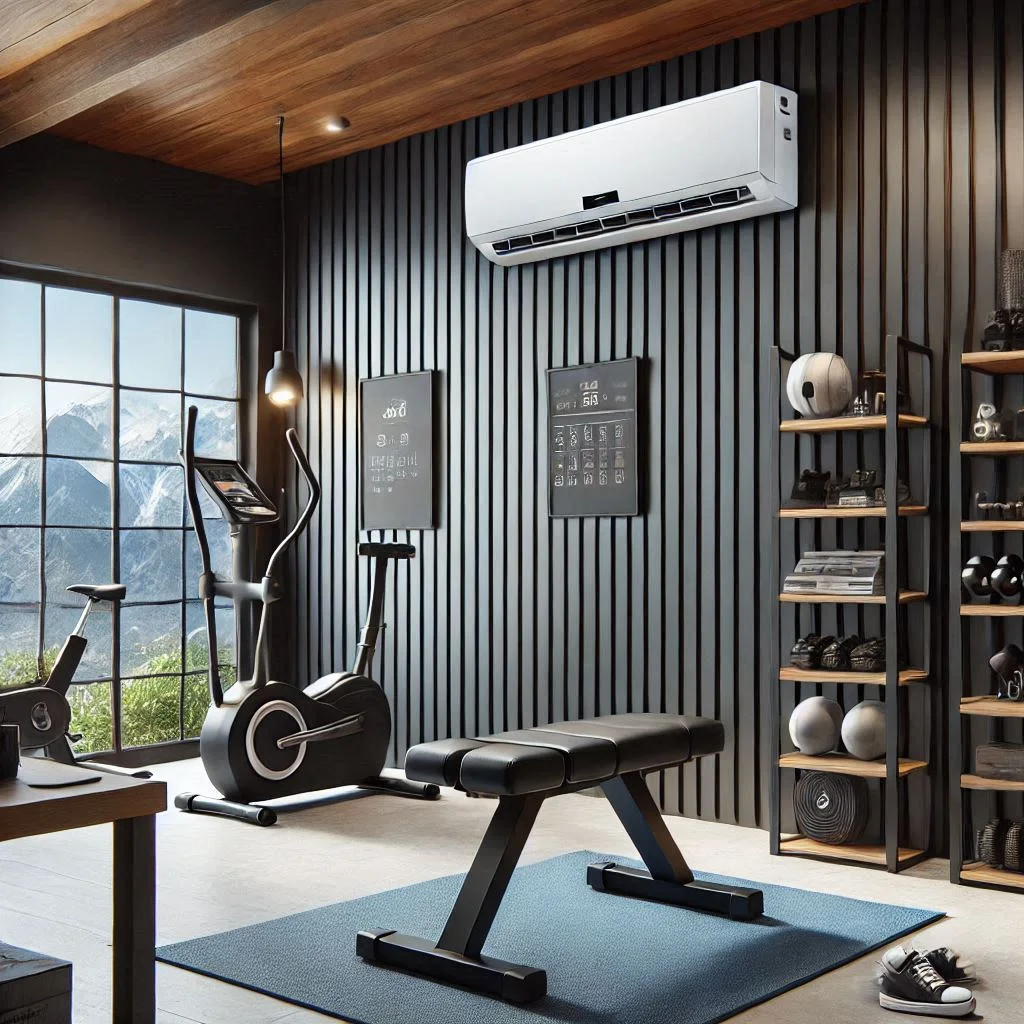
Best Value Garage Gym Air Conditioner
For those seeking the best value for their money without compromising on quality, the Whynter Portable Air Conditioner offers exceptional performance at an affordable price. This compact, easy-to-move unit provides powerful cooling and is perfect for smaller garage gyms where space is limited.
Unlike wall-mounted systems, the Whynter portable AC allows for easy mobility. You can roll it from one spot to another and even store it during the off-season. Its built-in dehumidifier and various cooling modes also add versatility to the cooling experience.
Features and Benefits:
- Affordable pricing: A budget-friendly option without sacrificing cooling power.
- Portability: Move it around the garage gym for targeted cooling.
- Dehumidifier mode: Helps reduce humidity, ensuring a dry and comfortable workout space.
- Efficient cooling: Cools a garage gym of up to 400 square feet, perfect for most home gym sizes.
Best suited for: Those on a budget who need a reliable air conditioner for a smaller garage gym that offers portability and ease of use.
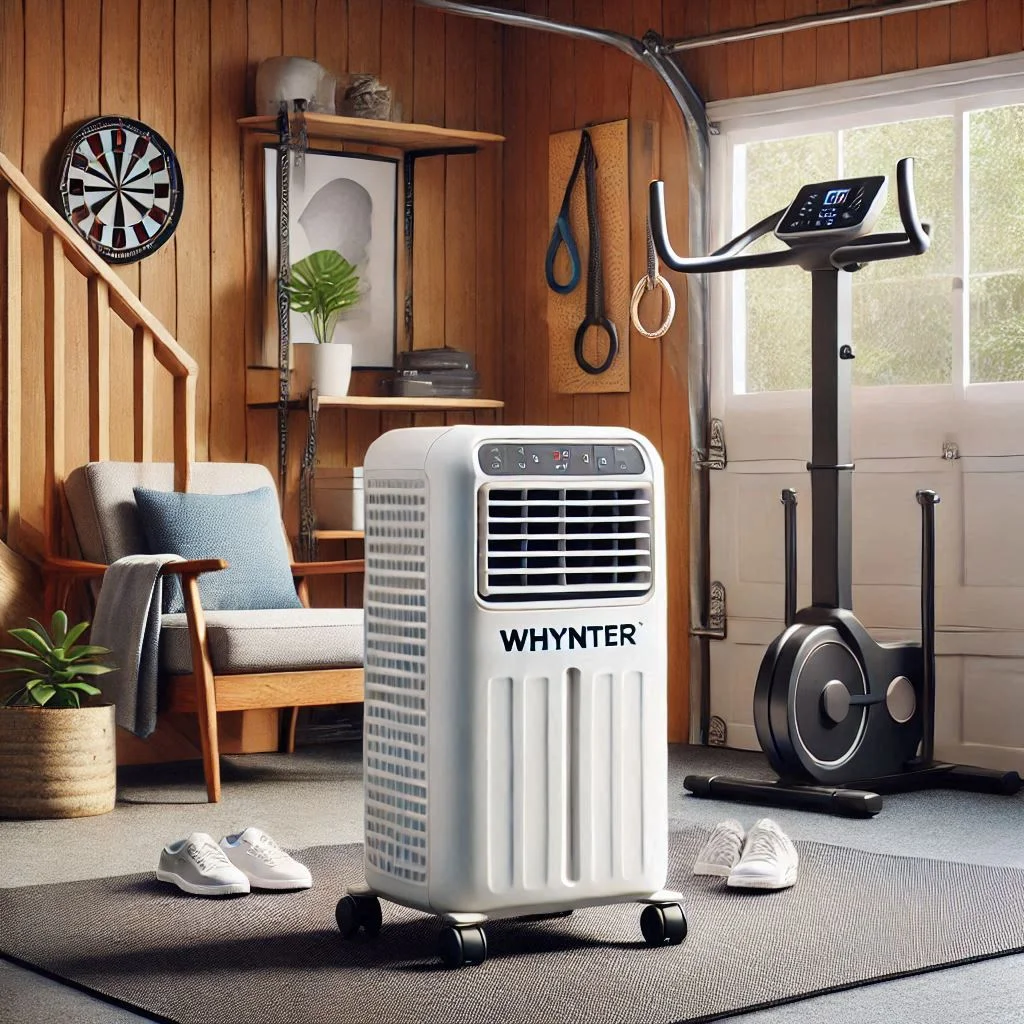
Best-Looking Garage Gym Air Conditioner
Incorporating an air conditioner that doesn’t just perform well but also adds to the aesthetics of your garage gym is key. The Haier 8000 BTU Window Air Conditioner is an excellent option that combines functionality with sleek design. Its modern, minimalist look ensures it complements your gym’s overall aesthetic without being a visual distraction.
The Haier window AC unit is designed to fit into most standard window sizes, providing powerful cooling while blending in seamlessly with your space. With a cooling capacity of 8000 BTU, it’s ideal for medium-sized garages and offers a perfect balance of style and performance.
Features and Benefits:
- Stylish design: A modern look that complements your gym decor.
- Effective cooling: 8000 BTU cooling capacity, ideal for moderate-sized garage gyms.
- Energy-efficient: Uses less energy while providing maximum cooling.
- Easy installation: Fits easily into most windows for quick installation.
Best suited for: Gym owners who prioritize both style and function, seeking a window AC unit that enhances the overall look of their gym.
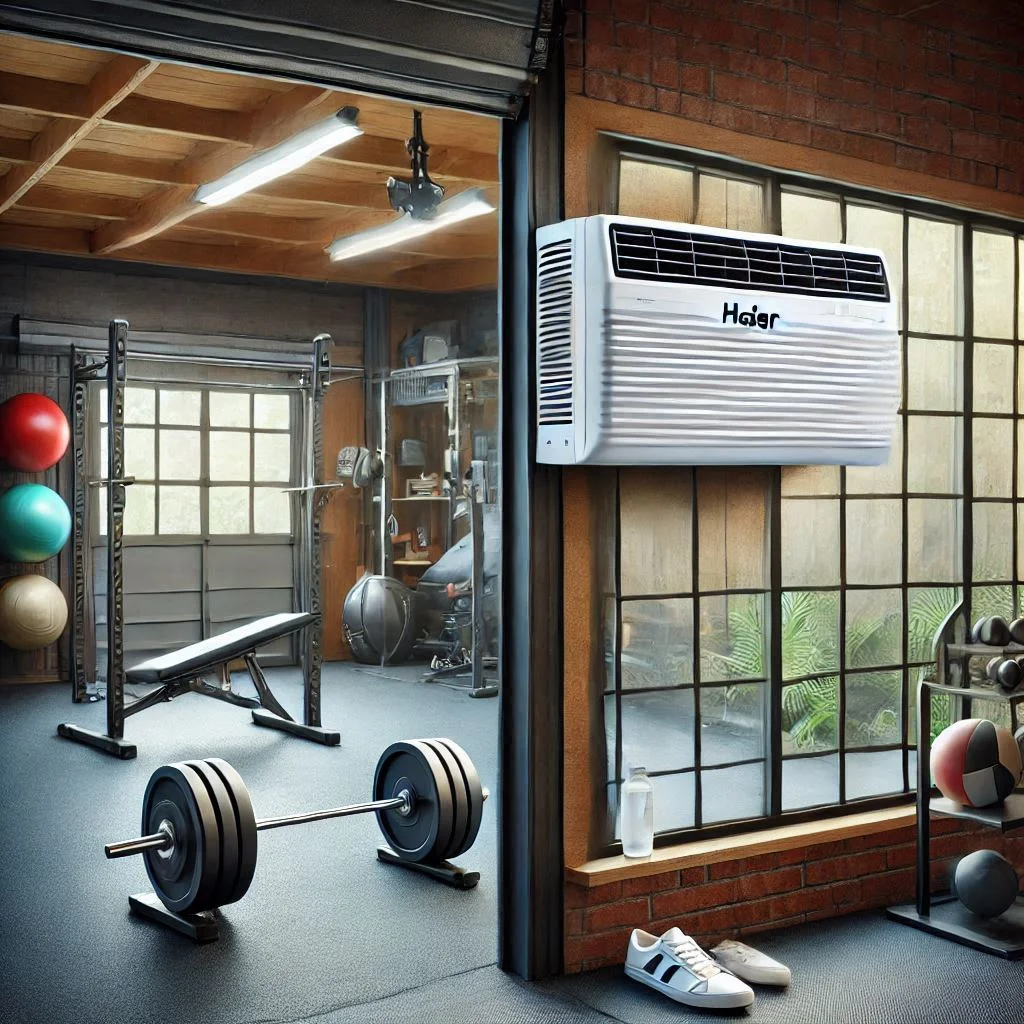
How to Cool Your Garage Gym Effectively
Cooling your garage gym effectively is essential for maintaining a comfortable and productive workout environment. High temperatures in your garage can lead to discomfort, dehydration, and reduced performance. Fortunately, there are several strategies to cool your garage gym effectively, enhancing both your workout experience and the longevity of your equipment. Below are practical tips to help you achieve the perfect temperature in your garage gym.
Clear the Clutter
One of the most effective ways to improve airflow and keep your garage gym cool is by clearing out any unnecessary clutter. Excess items can trap heat and block airflow, making the space feel hotter. By creating an organized, open space, you allow the air to circulate freely, helping to reduce the temperature.
Benefits of Clearing Clutter:
- Improved airflow: Open space encourages better ventilation and airflow.
- Cooler environment: Less clutter means less heat retention from stored items.
- Better workout space: A clear gym gives you more room to move and exercise.
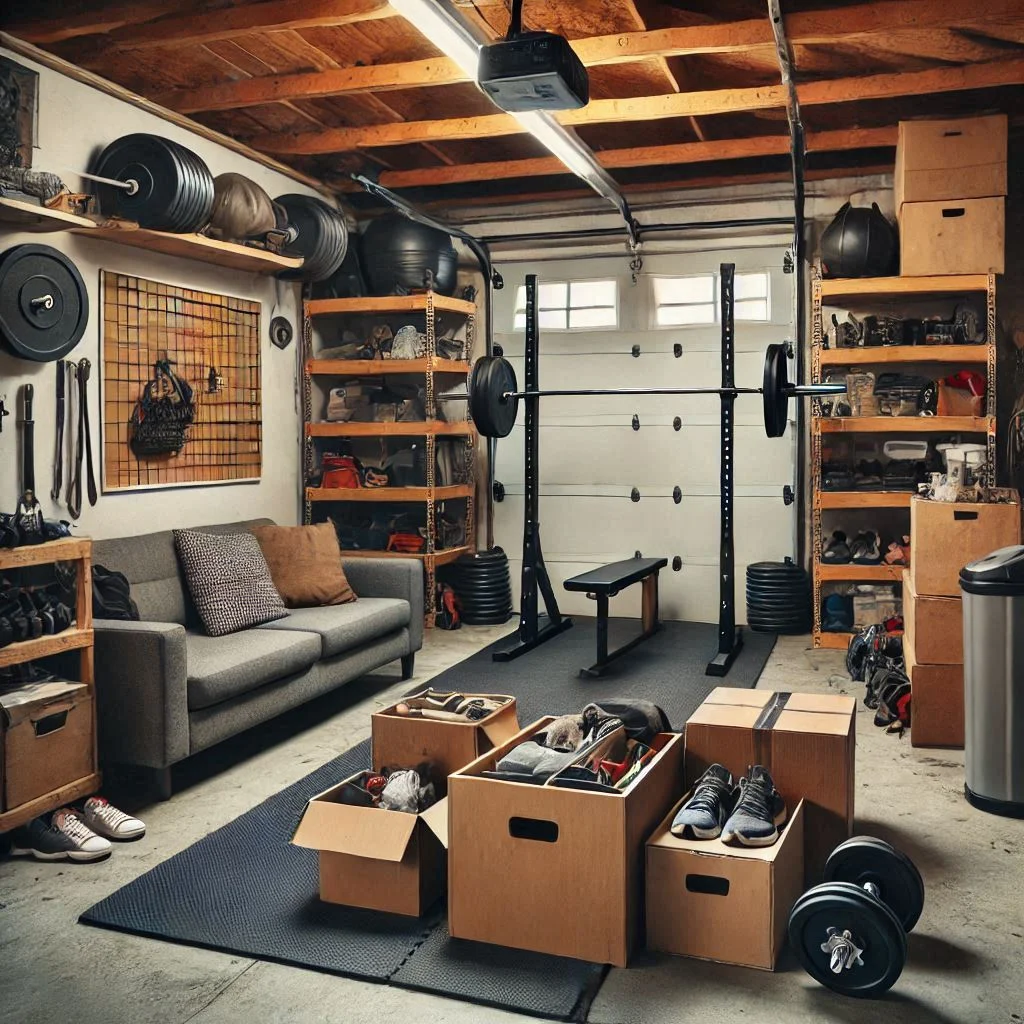
Keep the Garage Door Open for Ventilation
One simple yet effective way to cool your garage gym is by keeping the garage door open when you’re working out. This allows fresh air to flow through the space, helping to regulate the temperature naturally. Cross-ventilation can be particularly beneficial during cooler times of the day, such as early mornings or late evenings.
Benefits of Keeping the Door Open:
- Natural ventilation: Open doors promote cross-breezes that cool the space.
- Cost-effective: This is a free method to lower the temperature without relying on AC.
- Improved air quality: Fresh air can replace stale, warm air that builds up in the garage.
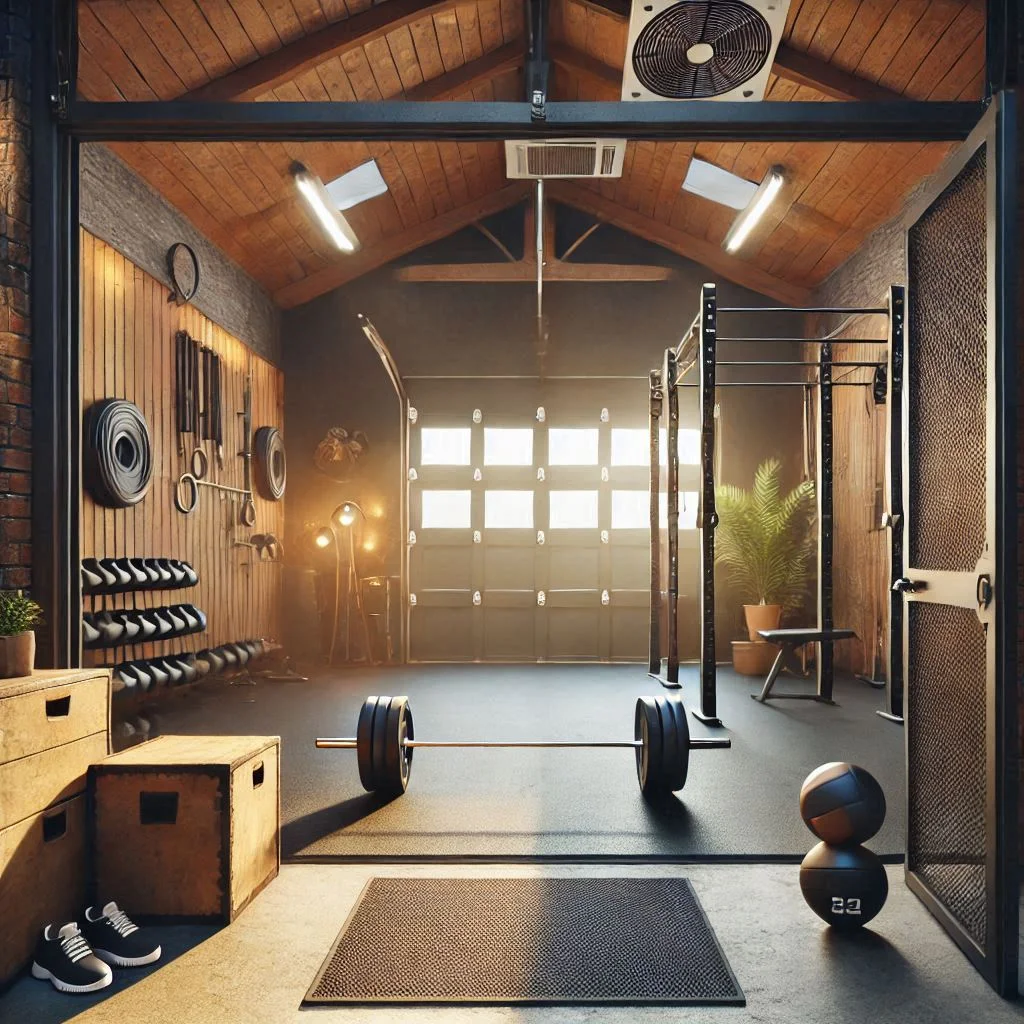
Go Green and Use Energy-Efficient Solutions
Adopting energy-efficient solutions not only helps lower your electricity bills but also keeps your garage gym cool while minimizing environmental impact. Consider installing LED lights, energy-efficient AC units, or even solar-powered fans. These green solutions will help maintain a cooler atmosphere while reducing the load on your power grid.
Energy-Efficient Solutions to Try:
- LED lighting: Switch from incandescent lights to energy-efficient LEDs that emit less heat.
- Solar-powered fans: These fans draw in cool air without increasing your energy consumption.
- Energy-efficient AC units: Invest in modern, energy-saving air conditioners that are both effective and eco-friendly.
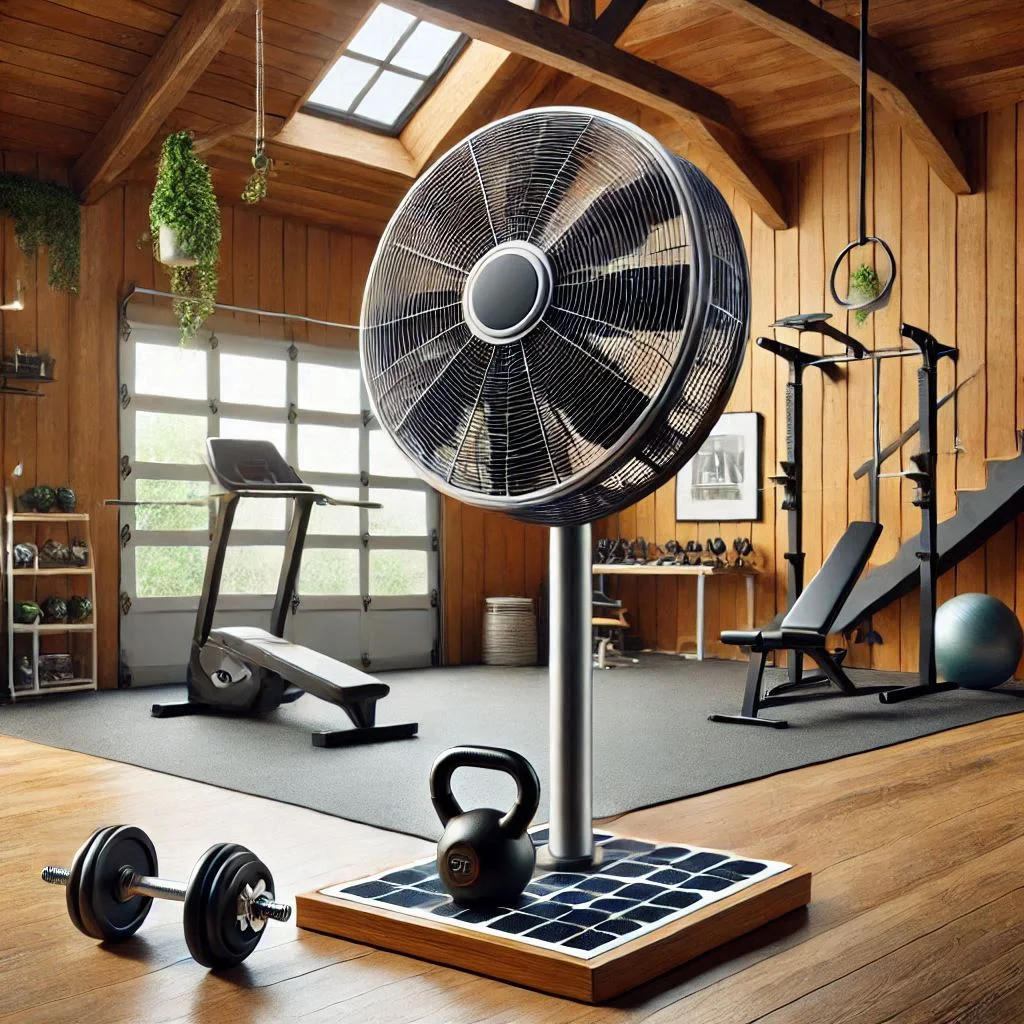
Use Fans to Enhance Airflow
If you don’t want to rely solely on an air conditioner, using high-quality fans can be a great alternative to keep your garage gym cool. Fans help circulate the air and can be strategically placed to direct airflow towards you while working out. You can also pair fans with your AC system for enhanced cooling.
Benefits of Using Fans:
- Affordable: Fans are a budget-friendly solution for cooling.
- Improved circulation: Fans help distribute cool air evenly throughout the garage.
- Increased comfort: Enhance the effectiveness of air conditioning by using fans in tandem.
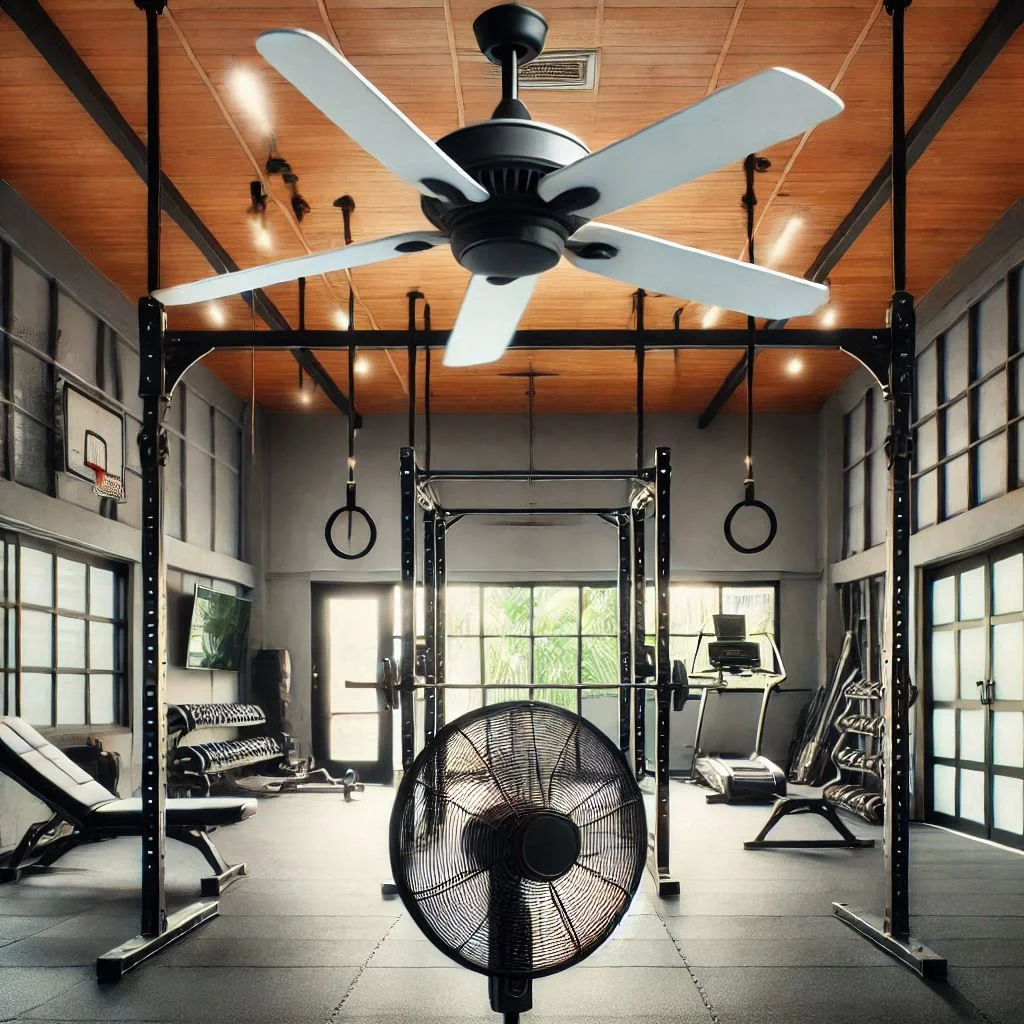
Upgrade the Insulation for Better Cooling
Proper insulation is key to maintaining a stable temperature in your garage gym. Poor insulation leads to heat retention during summer and heat loss during winter, making it harder to control the climate in your garage. Upgrading your garage’s insulation—whether it’s in the walls, ceiling, or garage door—will help keep the temperature more consistent year-round.
Benefits of Upgrading Insulation:
- Temperature control: Insulation helps maintain a cooler garage gym in the summer.
- Energy savings: Proper insulation reduces the strain on your AC, lowering energy bills.
- Noise reduction: Insulation can help reduce outside noise, allowing for a more peaceful workout environment.
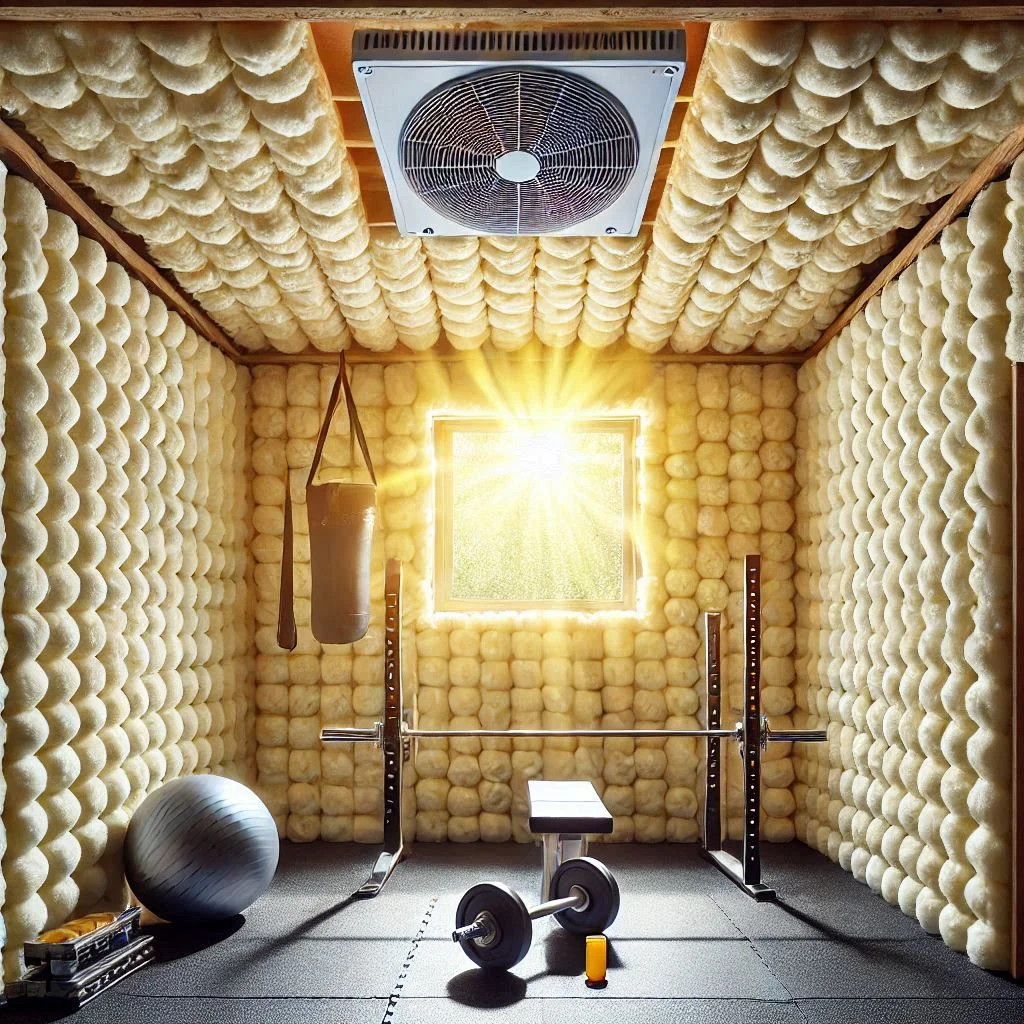
Consider a Fresh Paint Job for Better Cooling Efficiency
A fresh paint job can do more than just make your garage gym look good. Using reflective or light-colored paint on the walls and ceiling can help keep the space cooler. These colors reflect heat rather than absorb it, helping to reduce the internal temperature of your garage. A fresh coat of paint will enhance your garage gym’s cooling efficiency and make the space more enjoyable to work out in.
Benefits of a Fresh Paint Job:
- Reflects heat: Light-colored or reflective paint reduces heat absorption.
- Improved cooling efficiency: By reducing heat, your AC and fans work more effectively.
- Aesthetic improvement: A new paint job can give your garage gym a fresh, clean look.
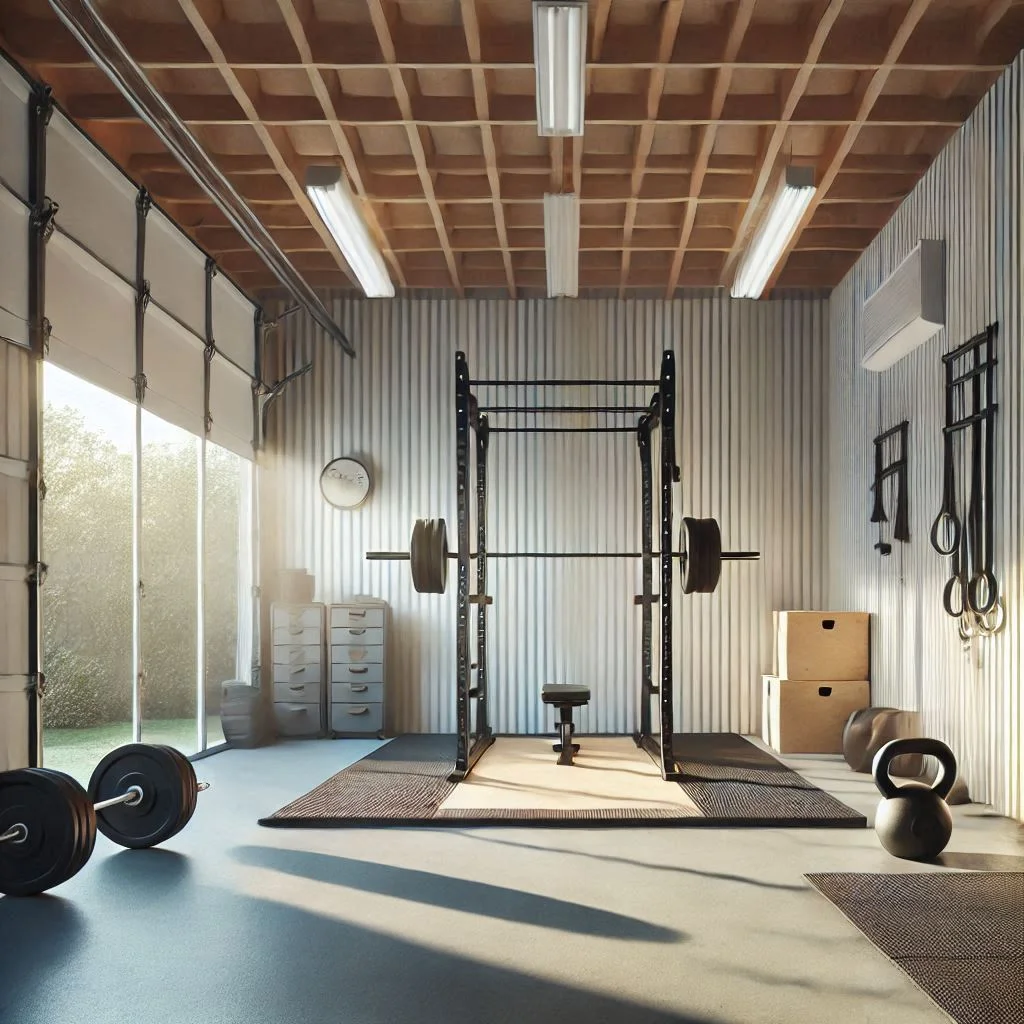
Can You Put an Air Conditioner in a Garage Gym?
Yes, you absolutely can install an air conditioner (AC) in your garage gym, and it’s often the best solution to make the space comfortable for intense workouts. Cooling your garage gym can increase your workout performance, enhance your overall comfort, and protect your equipment from heat damage. However, choosing the right air conditioning solution for your garage gym requires understanding several factors, including the type of AC, its size, and where to place it for optimal cooling efficiency.
Choosing Between Commercial and Home AC Units
When it comes to selecting the right air conditioner for your garage gym, one of the first decisions you’ll need to make is whether to go with a commercial or home AC unit. Both have their pros and cons, so it’s important to assess your needs and your garage gym’s size to make the best choice.
Commercial AC Units:
- Pros: Commercial AC units are designed for larger, more demanding spaces, making them ideal for bigger garages. They provide powerful cooling and are typically more durable and capable of cooling larger areas.
- Cons: Commercial units tend to be more expensive and can consume more electricity. They also require professional installation, making the setup more complicated and costly.
Home AC Units:
- Pros: Home AC units are more affordable and efficient for smaller garage spaces. They are typically easy to install and are designed to be user-friendly. These units come in several types, including window ACs, portable units, and ductless mini-splits, each with varying capacities.
- Cons: Home AC units may not be powerful enough for larger garages and may struggle with keeping a larger space cool during peak summer temperatures.
Best for: Choose a commercial AC if you have a large garage gym that needs heavy-duty cooling. A home AC unit is ideal for smaller or medium-sized spaces where efficiency, cost-effectiveness, and ease of use are priorities.
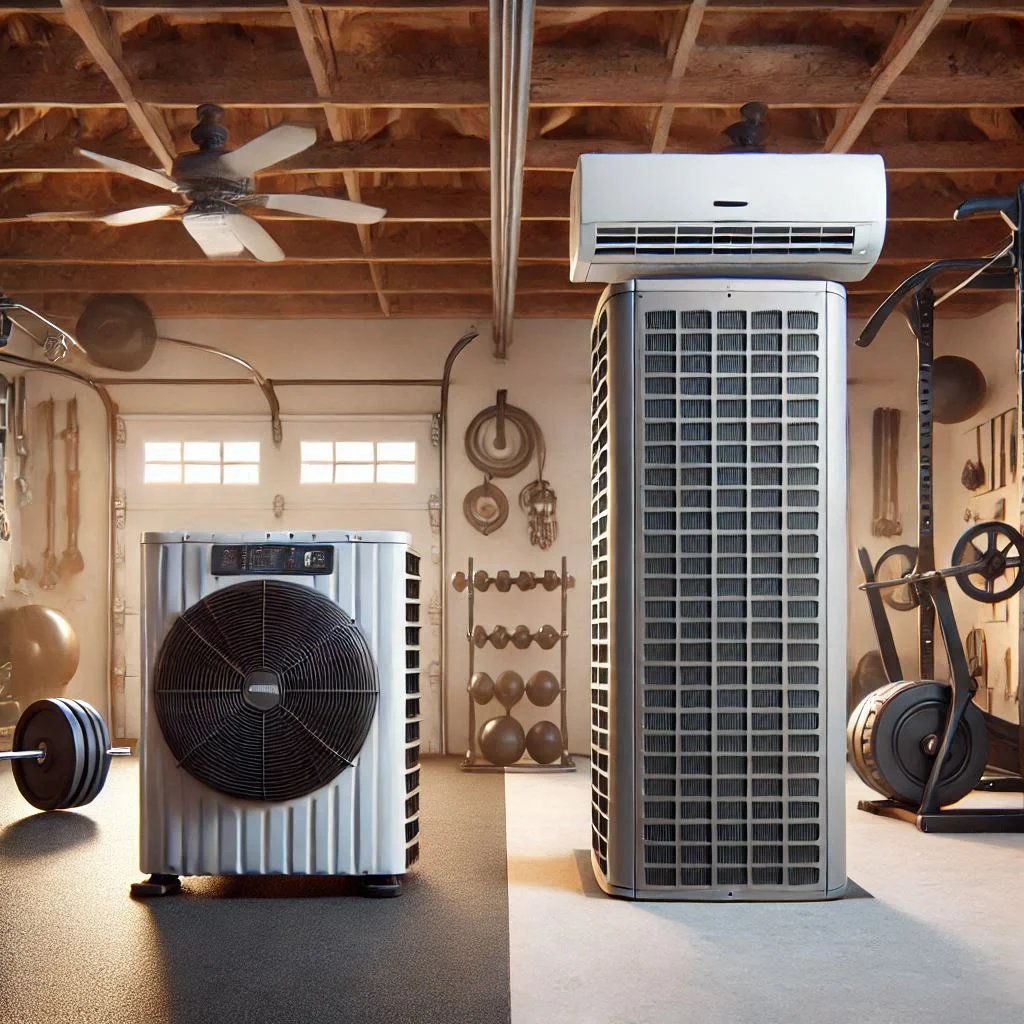
Pick the Right Size AC Unit for Your Garage Gym
Selecting the correct size air conditioner for your garage gym is crucial for efficiency. An undersized unit will struggle to cool the space and consume more energy, while an oversized unit can cool too quickly, causing the space to feel humid and uncomfortable. The size of the AC unit is usually measured in BTUs (British Thermal Units), which indicates how much cooling power it provides.
To choose the right size AC, you’ll need to consider the following:
- Square footage of your garage: Larger spaces need higher BTU ratings. For example, a 10×20-foot garage may require a 6,000-8,000 BTU unit, while a 20×20-foot garage may need a 12,000 BTU unit.
- Insulation: Better insulation keeps the cold air inside and reduces the load on the AC. If your garage gym is poorly insulated, you may need a more powerful unit.
- Climate: If you live in a particularly hot climate, you may need an AC unit with more BTUs to keep your gym comfortable.
- Sun exposure: If your garage gym has a lot of windows or direct sunlight, it will naturally heat up, and you’ll need a larger AC unit to compensate for the heat.
How to calculate the ideal BTU:
- For a well-insulated garage, use about 20 BTUs per square foot of space.
- For poor insulation or areas with direct sunlight, you may need to increase the BTU calculation.
Best for: Choose an AC size based on the square footage of your garage gym and factors such as insulation, sun exposure, and your climate.
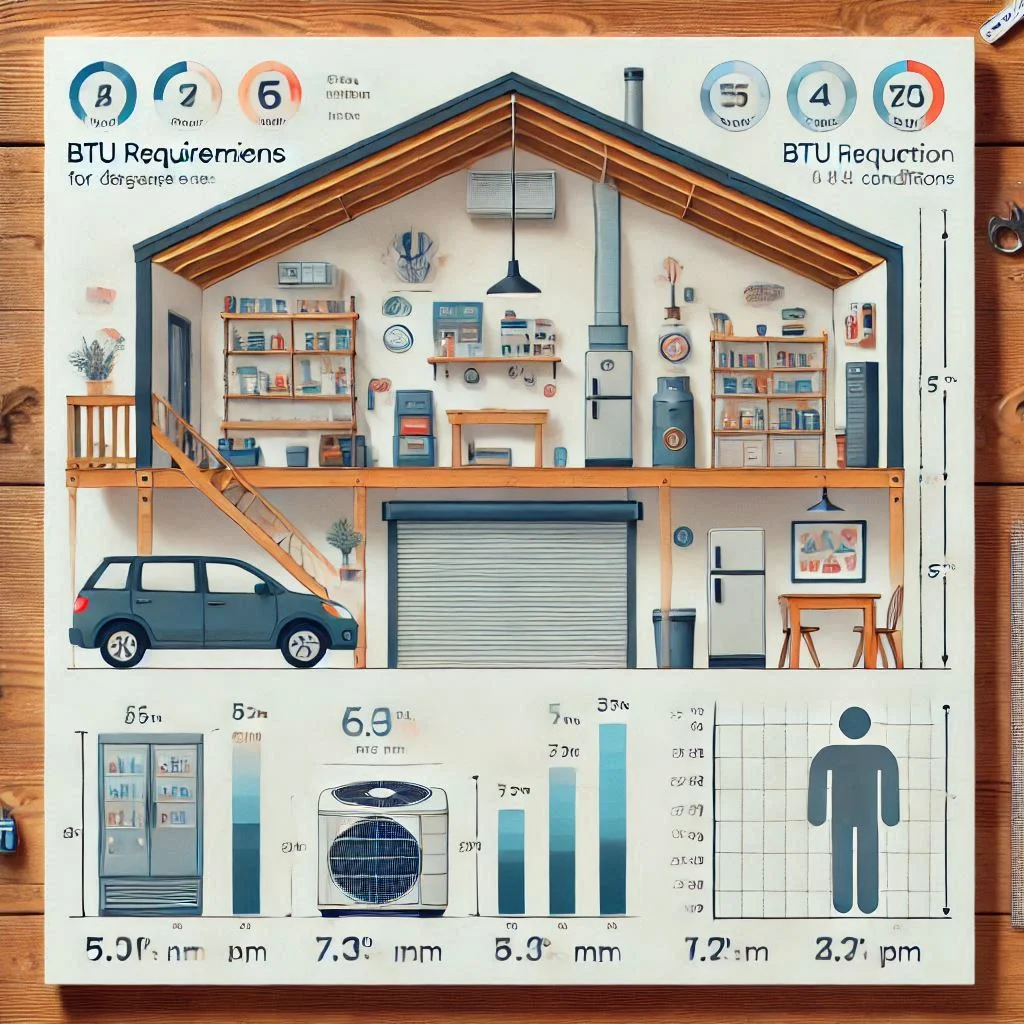
Ideal Placement for Ventilation and Cooling Efficiency
The placement of your air conditioner plays a major role in the efficiency of cooling in your garage gym. Proper placement ensures optimal airflow, maximizes cooling capacity, and reduces the strain on your AC unit. Below are key considerations for the best placement:
- Away from direct sunlight: Position your AC unit away from windows that receive direct sunlight. Placing the unit in the shade will help it operate more efficiently.
- Close to workout areas: Install the AC near the area where you spend the most time during workouts. This ensures that you benefit from the cooling without unnecessary energy loss.
- Good airflow: Make sure the unit is not obstructed by furniture or equipment. It’s best to place it where it can distribute cool air evenly throughout the space.
- Ventilation: If you are using a window AC or a portable unit, make sure the exhaust hose or vent is positioned properly to expel hot air outside, preventing it from circulating back into the gym.
- High or low placement: Some people prefer wall-mounted units at a higher level to allow the cool air to flow downwards. Alternatively, floor models like portable ACs work well if space allows.
Best for: The ideal AC placement is in a central location that maximizes cooling efficiency and airflow, allowing you to enjoy a comfortable workout experience without interruption.
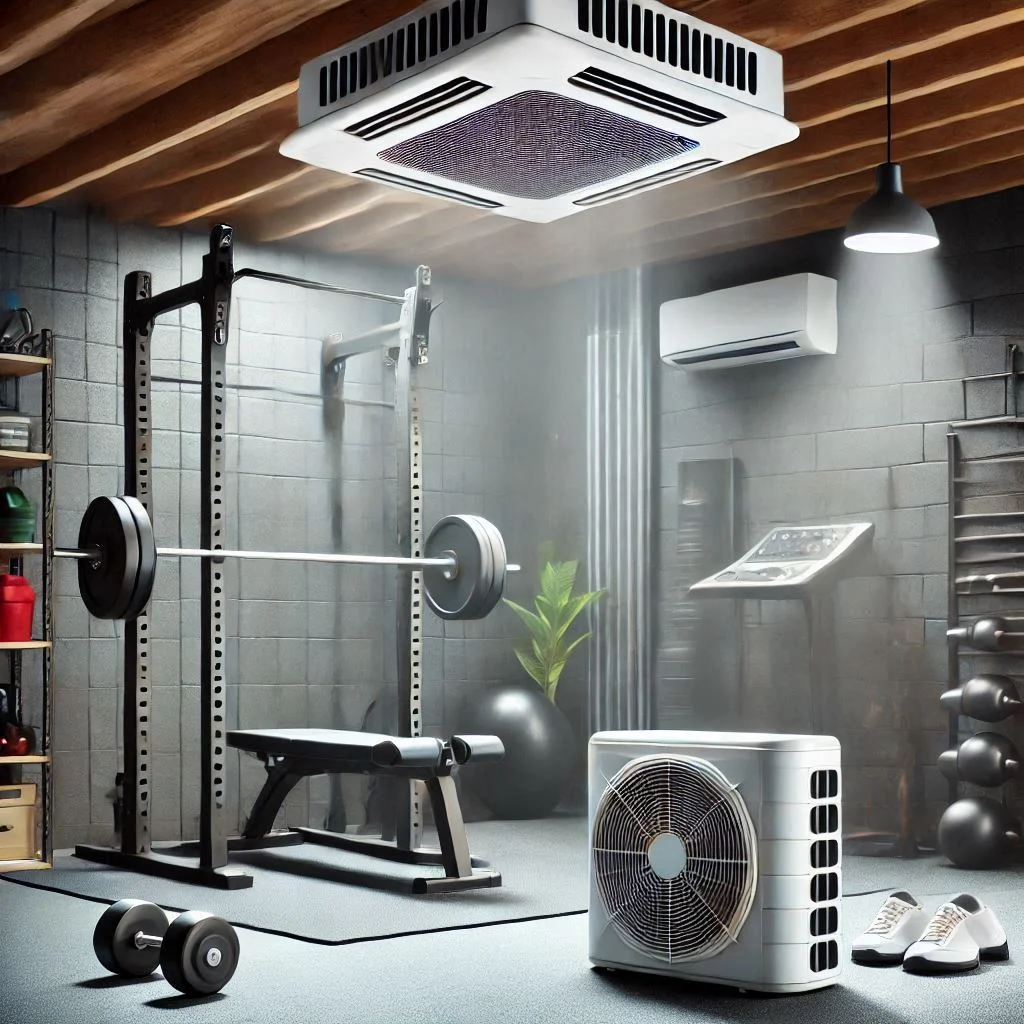
Types of Air Conditioners for Garage Gyms
When it comes to cooling your garage gym, choosing the right type of air conditioner (AC) is essential for achieving maximum comfort and efficiency. Garage gyms often face unique challenges, such as varying temperature fluctuations and a larger space to cool. Selecting the best AC system will not only help maintain a comfortable temperature but also ensure energy efficiency. Below are the most common types of air conditioners used in garage gyms, each with its pros and cons.
Mini Split Air Conditioners for Garage Gyms
Mini split air conditioners, also known as ductless systems, are one of the most efficient and flexible cooling solutions for garage gyms. They consist of an outdoor unit and an indoor unit that is mounted on the wall. Mini splits are ideal for garage gyms because they do not require ductwork, making them easier to install in spaces where traditional AC systems might not fit.
Pros and Cons of Ductless Mini-Split Units:
Pros:
- Efficient cooling: Mini splits provide precise temperature control and efficient cooling for a garage gym.
- No ductwork: These systems don’t require ducts, making them perfect for garages with limited space or no existing ductwork.
- Quiet operation: The outdoor unit is very quiet, and the indoor unit can be mounted on the wall, further reducing noise levels.
- Zoned control: Many mini splits come with multi-zone options, allowing you to cool specific areas of your garage gym, which is ideal for large spaces.
- Energy-efficient: Mini splits use less energy compared to traditional AC units and can be highly cost-effective in the long run.
Cons:
- Higher upfront cost: While mini splits are energy-efficient, they often have a higher initial cost compared to other AC systems.
- Installation complexity: These units require professional installation, which can add to the overall cost and time involved.
- Space requirements: The indoor unit needs to be mounted on a wall, which may require extra space.
Best for: Mini splits are perfect for large garage gyms, especially those that need efficient, targeted cooling without the need for ducts.
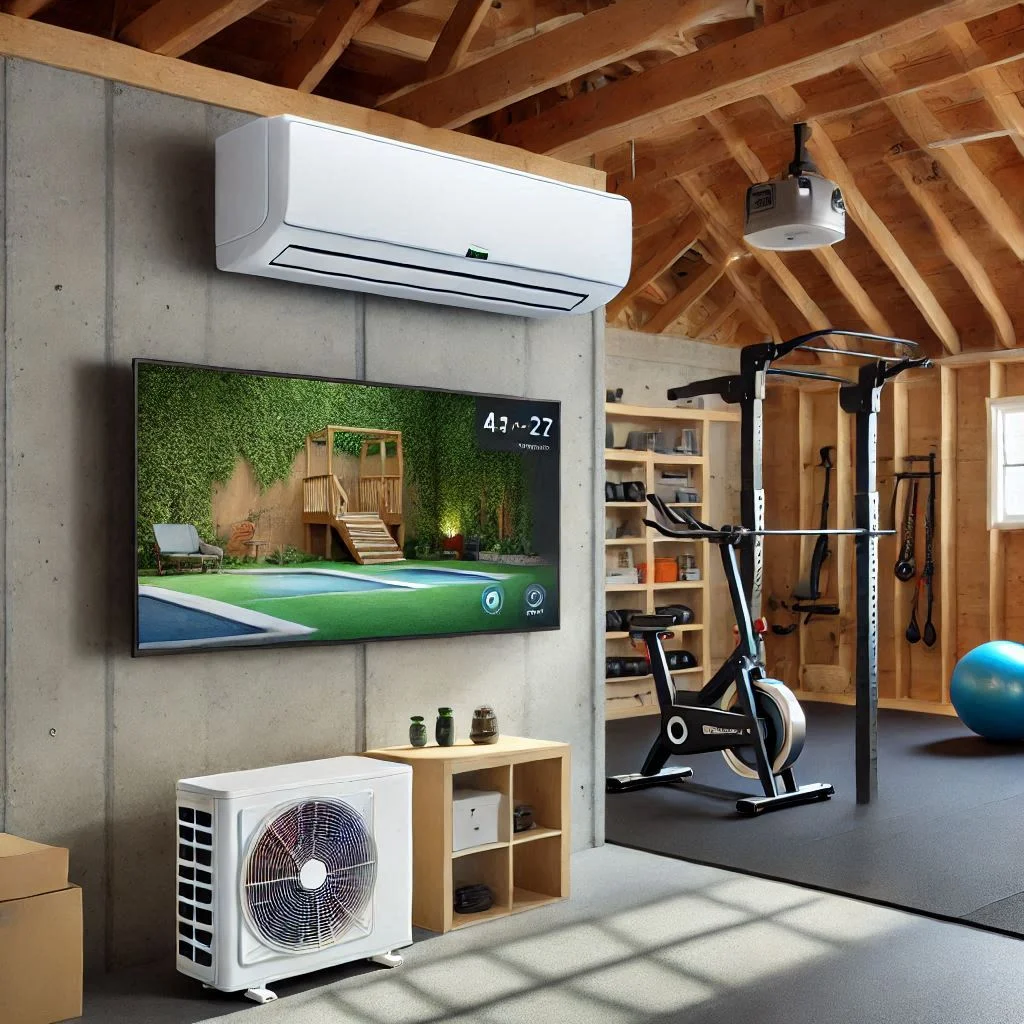
Window Air Conditioners
Window air conditioners are a popular and affordable cooling option for garage gyms. These units are installed in a window, drawing in outdoor air to cool and circulate inside the gym. Window ACs are typically more cost-effective than other systems, making them a good choice for those on a budget.
Pros and Cons of Window AC Units:
Pros:
- Affordable: Window ACs are generally less expensive both in terms of purchase price and installation.
- Easy installation: These units can often be installed by the homeowner, making them a good DIY project.
- Compact design: Window ACs are space-efficient, sitting directly in the window and not taking up valuable floor or wall space.
- Efficient cooling for smaller spaces: For small to medium-sized garage gyms, window AC units are a cost-effective solution for quick and effective cooling.
Cons:
- Limited cooling power: Window units are not ideal for larger garage gyms, as they may struggle to cool a big area.
- Installation limitations: Not all garages have the ideal window setup, so this option may not be viable in some spaces.
- Noise: Window AC units can be noisy, which may interfere with your workout if the gym is located near the unit.
- Security risk: Since the unit is installed in a window, it can pose a potential security risk if not properly secured.
Best for: Window AC units are best for smaller garage gyms or those looking for a budget-friendly, simple solution to cool their space.
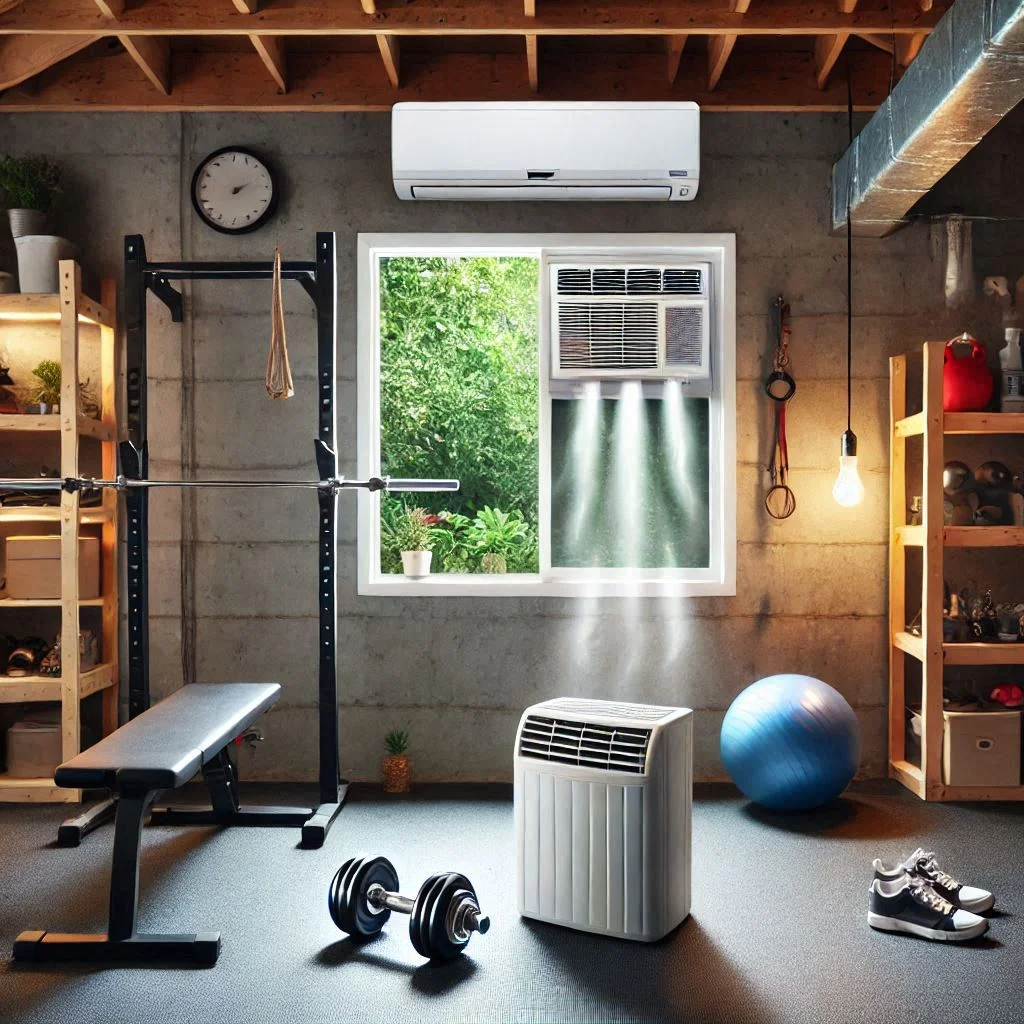
Portable Air Conditioners for Garage Gyms
Portable air conditioners are another great option for garage gyms, offering flexibility and mobility. These units can be moved around the space and are ideal for those who do not want to install a permanent cooling system. Portable ACs are generally easy to use, and the installation process is minimal.
Pros and Cons of Portable Units:
Pros:
- Flexibility: Portable units can be moved to different areas of the garage gym, providing targeted cooling where it’s most needed.
- No installation required: These units don’t require permanent installation, making them perfect for renters or those looking for a temporary solution.
- Affordable: Portable ACs are generally more affordable than mini-split or window units.
- Space-saving: Since the unit is on wheels, it doesn’t take up permanent space in the gym, and the venting hose can be directed out through a window or vent.
Cons:
- Limited cooling capacity: Portable units may struggle to cool larger garage gyms, and they can be less efficient compared to mini splits or window units.
- Noise: These units can be noisy during operation, which could be a distraction during intense workouts.
- Exhaust hose: The exhaust hose needs to be vented out of a window or door, which can be cumbersome and reduce the overall aesthetic of the garage.
Best for: Portable ACs are perfect for smaller to medium-sized garage gyms where flexibility and easy installation are priorities.
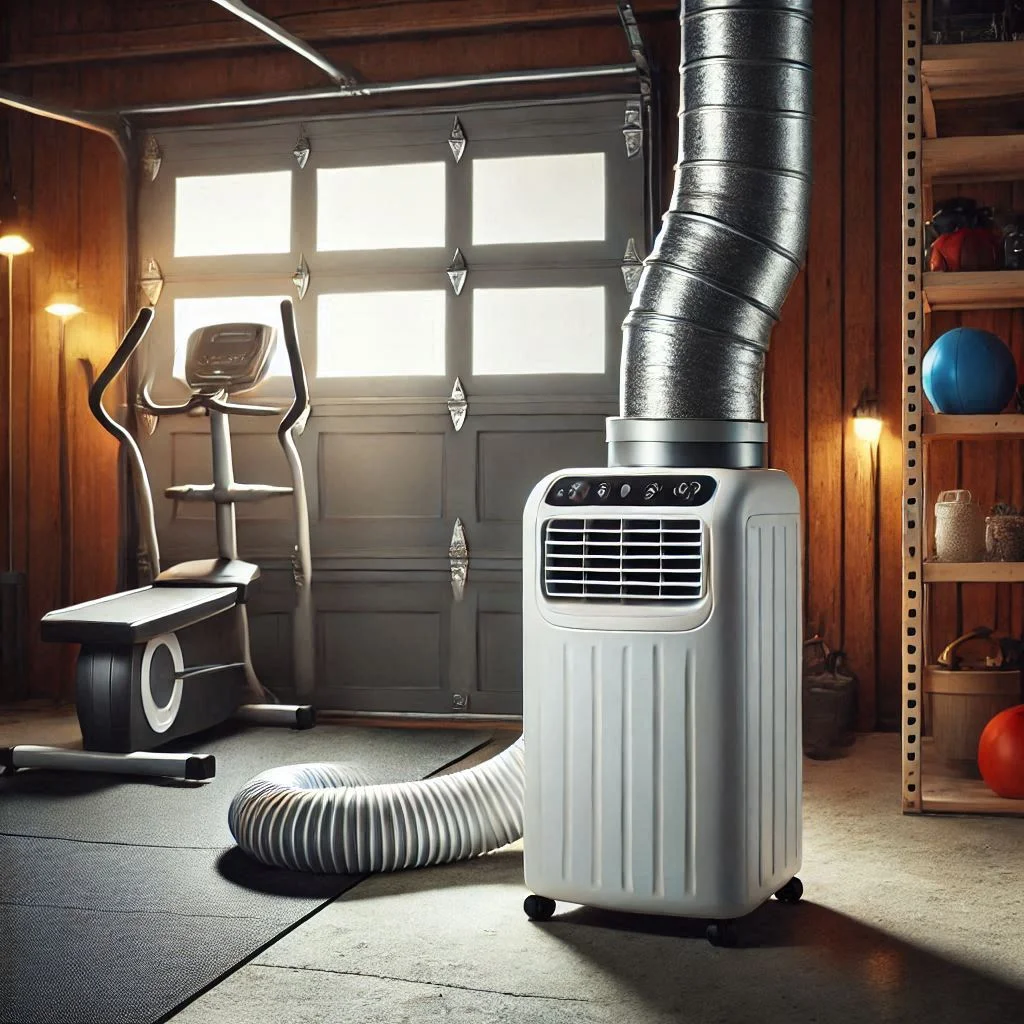
Is it Worth Installing an Air Conditioner in Your Garage Gym?
Installing an air conditioner (AC) in your garage gym is an investment that can significantly improve your workout environment. With proper climate control, your gym can stay comfortable year-round, enhancing performance and safety. But is it really worth the expense and effort? Let’s explore the key factors that determine whether adding an AC unit is the right choice for your garage gym.
Benefits of Portable AC Units for Garage Gyms
Portable AC units offer several advantages for those looking to cool their garage gym without the hassle of permanent installation. These compact and movable units provide flexibility and affordability, making them an excellent choice for many gym owners.
Benefits:
- Mobility and Flexibility: The primary advantage of portable AC units is their mobility. You can move them around the garage gym to target specific areas or even use them in different rooms. If your gym layout changes, the unit can adapt.
- Ease of Installation: Portable ACs require minimal installation. You simply need to set them up and vent the exhaust hose outside, often through a window or door. This makes them a great choice for people who don’t want to commit to permanent changes in their space.
- Cost-Effective: Portable units are typically less expensive than other AC systems, making them ideal for garage gym owners on a budget. Their initial cost is often much lower, and their energy consumption can be efficient when used strategically.
However, it’s important to note that portable ACs are best suited for smaller garage gyms or spaces with good airflow, as they may not have the power to cool larger areas effectively.
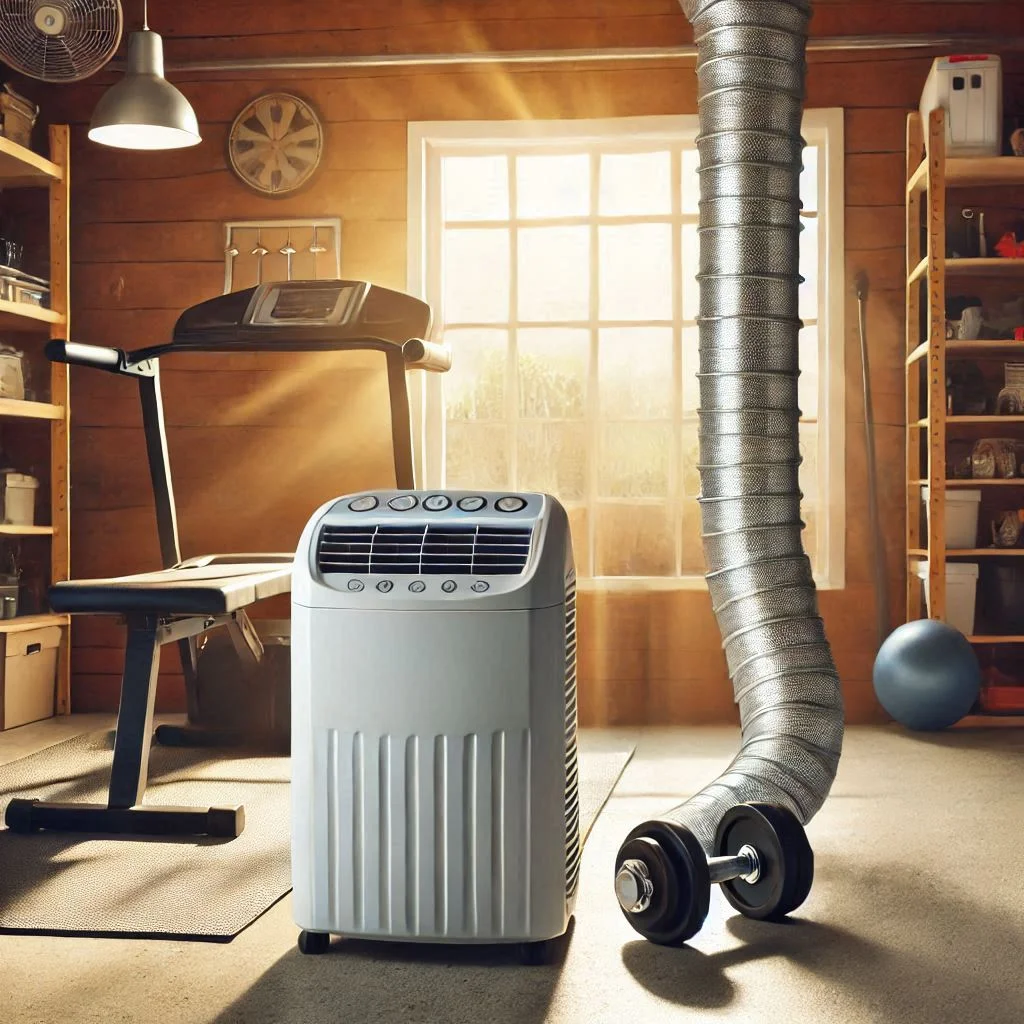
Ensuring the Right AC Size and Energy Efficiency
One of the most critical factors in air conditioning your garage gym is choosing the correct size of the AC unit. An improperly sized AC can lead to inefficient cooling, higher energy costs, and reduced comfort.
Key Considerations for AC Sizing:
- Square Footage: The size of the garage gym directly affects the cooling capacity required. Larger spaces need more powerful units to maintain a comfortable temperature.
- Insulation and Ventilation: If your garage is poorly insulated, you’ll need a more robust AC to overcome heat loss or gain. Similarly, rooms with limited airflow might require a unit that pushes more air through the space.
- Energy Efficiency: Select an AC unit with an energy efficiency rating (EER) or SEER (Seasonal Energy Efficiency Ratio). Higher ratings indicate better energy use, which translates to lower electricity bills.
When choosing the right unit, it’s also wise to consider additional features like programmable thermostats, timers, and energy-saving modes. These features will help optimize energy usage while ensuring that your garage gym remains cool and comfortable.
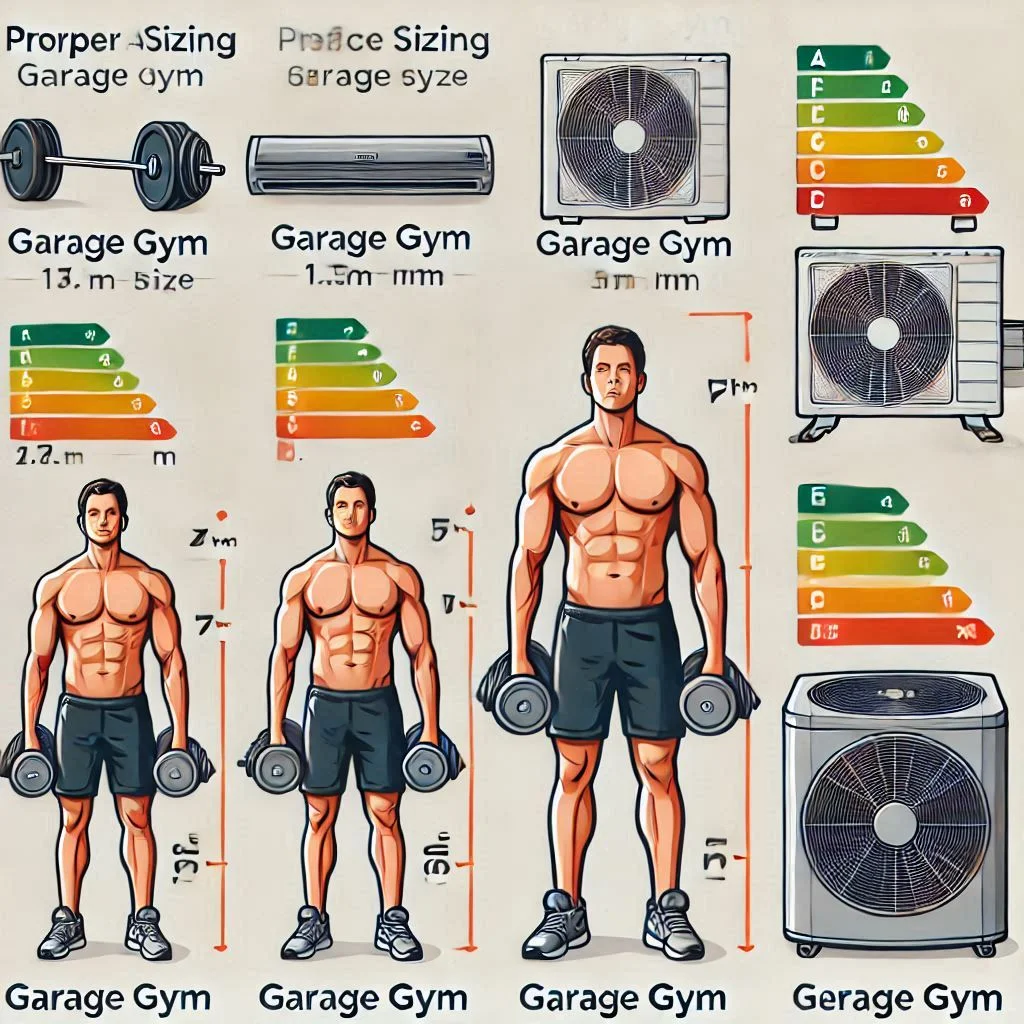
AC Maintenance and Longevity Tips
To ensure that your garage gym’s air conditioner performs well over time, regular maintenance is key. A well-maintained AC will last longer, operate efficiently, and provide consistent cooling.
Maintenance Tips:
- Clean or Replace Filters Regularly: Clogged filters reduce airflow and cooling efficiency. Clean or replace filters every 1–3 months, depending on the type of AC unit you have.
- Check for Leaks: Inspect the unit for any refrigerant leaks that could reduce its cooling capacity.
- Inspect Drain Lines: Ensure that the condensate drain lines are free from obstructions to prevent water damage and mold growth.
- Professional Servicing: Schedule an annual check-up with a professional HVAC technician to keep the system running at peak performance.
Regular maintenance not only ensures longevity but also improves the energy efficiency of your air conditioner, keeping your gym cooler without driving up your electricity bill.
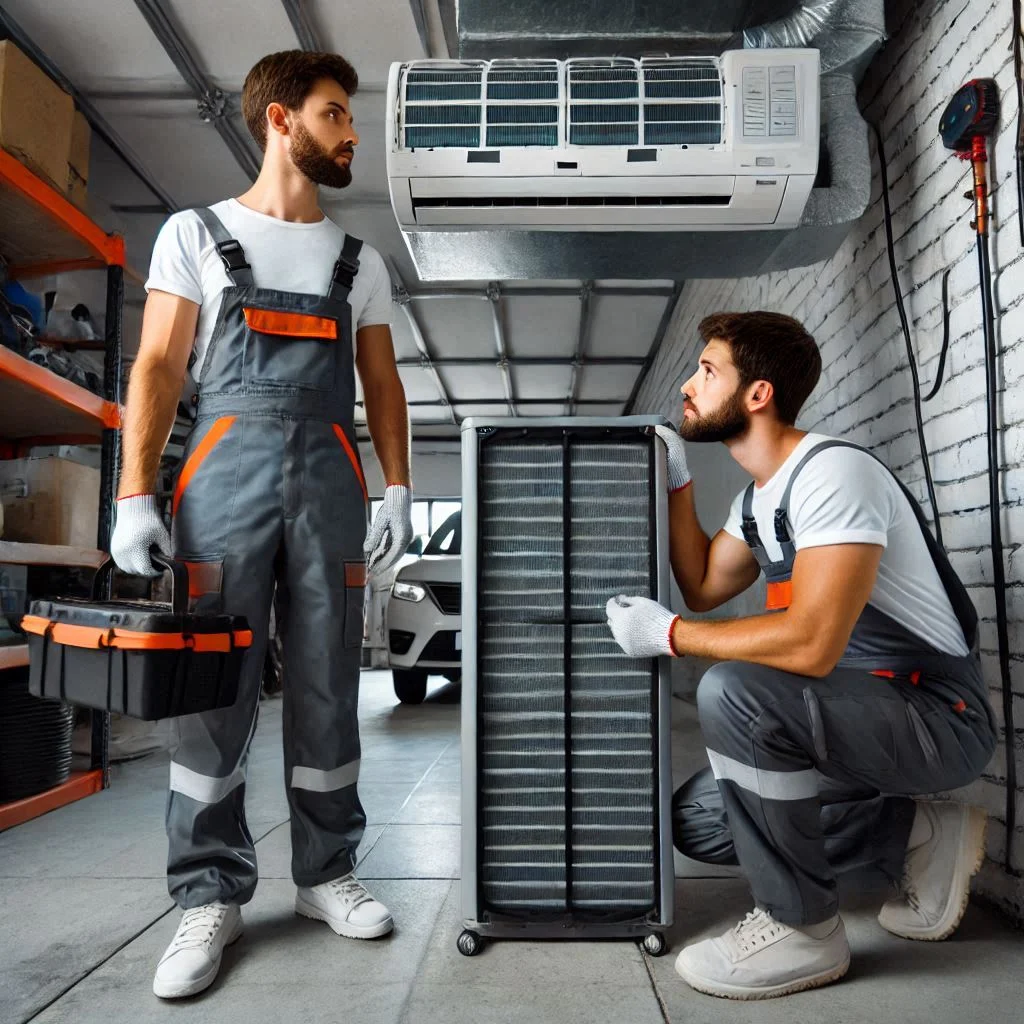
Noise Levels and How to Manage Them
Noise can be a significant concern, especially if you’re trying to focus during your workout. Air conditioners, particularly portable and window units, can produce noise, which may interfere with your gym experience.
Managing Noise:
- Choose Low-Noise Units: Look for AC units specifically designed for quieter operation. Ductless mini-split systems are typically quieter than window or portable units.
- Place the Unit Strategically: Position the AC unit away from your workout area or behind a partition to minimize noise disruption. For portable units, placing the unit near a door or window can help reduce the sound.
- Insulate the Garage: Insulating your garage can help dampen the sound from both the AC and the ambient noise outside, creating a quieter workout environment.
By choosing quieter models and placing them strategically, you can significantly reduce the noise while maintaining the cooling efficiency of your air conditioner.
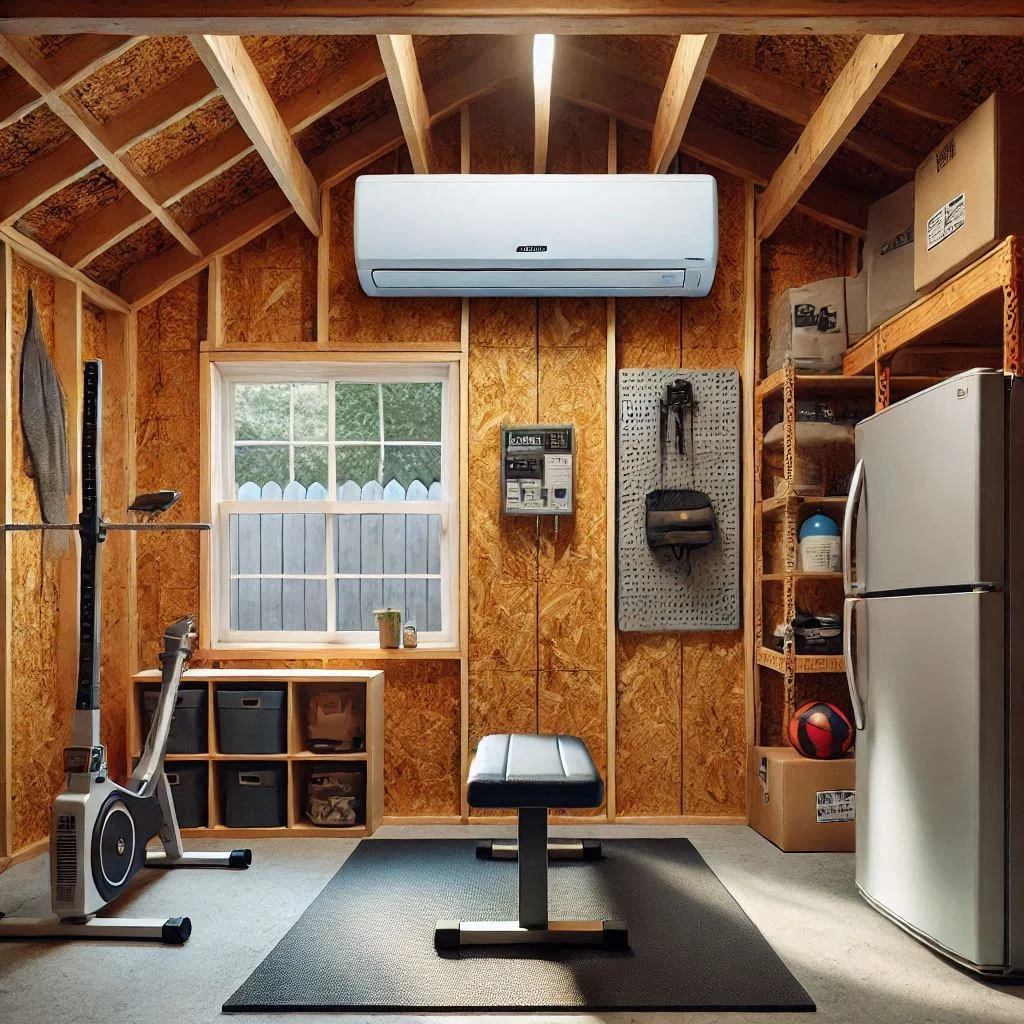
Achieving Optimal Energy Efficiency in Your Garage Gym
Achieving optimal energy efficiency is essential for keeping your cooling costs manageable. There are several strategies you can implement to make sure your garage gym AC unit operates efficiently without excessive energy consumption.
Tips for Optimal Energy Efficiency:
- Use Energy-Efficient Units: When purchasing an AC, check for Energy Star-rated models, which are designed to use less energy and reduce your carbon footprint.
- Set the Right Temperature: Avoid setting the thermostat too low. A temperature of 75–78°F is ideal for both comfort and energy savings.
- Seal Leaks: Ensure that all doors and windows are properly sealed to prevent cold air from escaping and warm air from entering. Gaps can make the AC work harder than necessary.
- Use Timers and Programmable Settings: Set your AC unit to turn on just before you start working out and turn off when you finish. This ensures that it only runs when needed, saving energy.
By applying these energy-saving techniques, you can enjoy a cool and comfortable garage gym without significantly increasing your utility bills.
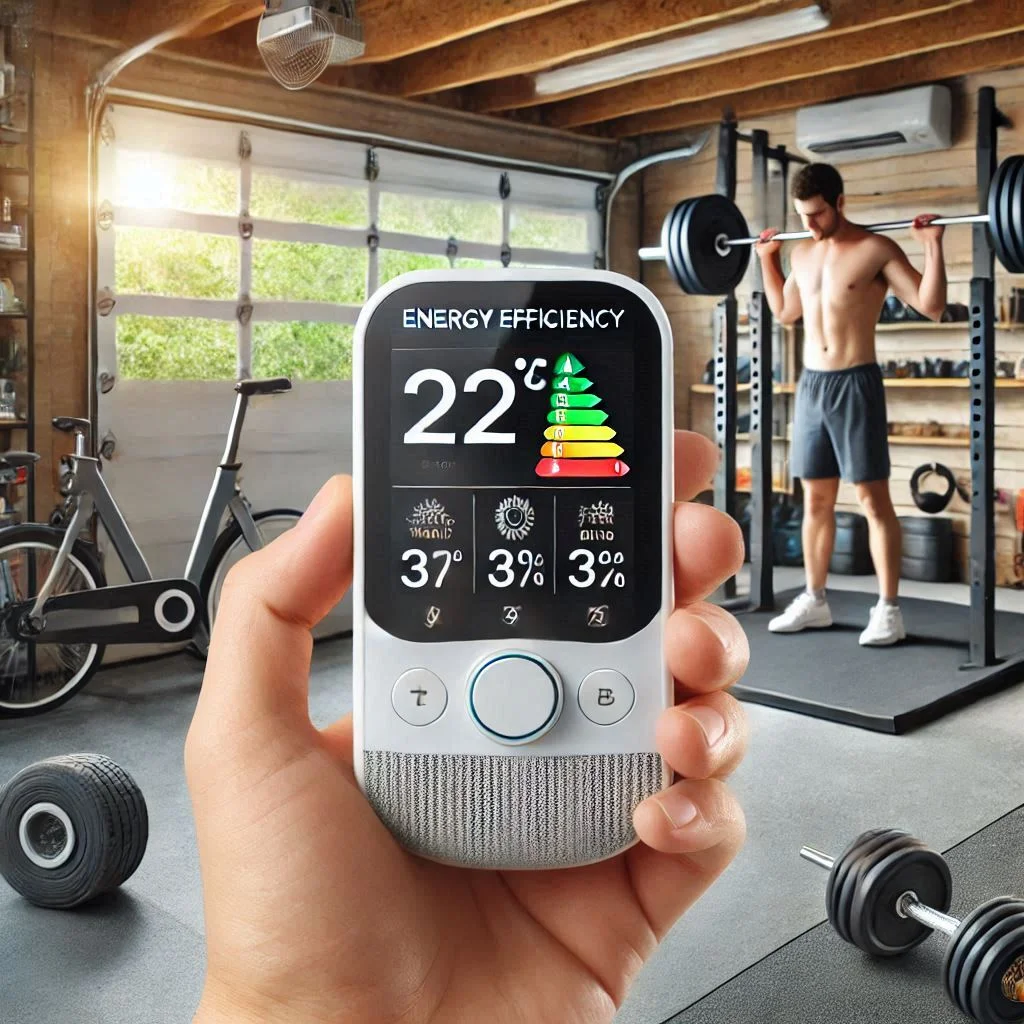
How to Maintain Your Garage Gym AC for Optimal Performance
Maintaining your air conditioner (AC) is essential to ensure that it continues to work efficiently in your garage gym. Regular maintenance not only prolongs the lifespan of your unit but also ensures that your workouts remain comfortable, no matter the temperature outside. With proper care, your AC can provide consistent performance year-round. In this guide, we’ll walk you through the essential maintenance steps to keep your garage gym’s AC in top shape.
Regular Cleaning and Filter Replacement
One of the simplest yet most effective maintenance tasks for your garage gym’s AC is regular cleaning and filter replacement. Over time, dust, dirt, and debris can accumulate in the filters, reducing airflow and cooling efficiency.
Why Regular Cleaning is Important:
- Improves Airflow: A clogged filter restricts airflow, making the AC work harder to cool the space. Regularly cleaning or replacing the filter ensures that the system can circulate air efficiently.
- Enhances Cooling Performance: A clean filter allows the AC to cool the room more effectively, ensuring that your garage gym stays at the optimal temperature for your workout.
- Promotes Better Air Quality: Filters trap dust and allergens, preventing them from circulating in the air. Regularly replacing the filter can improve the overall air quality in your gym.
How to Clean and Replace Filters:
- Turn off the AC before performing any maintenance to ensure safety.
- Remove the filter (usually located behind a grill or cover).
- Vacuum the filter to remove dust, or rinse it with water if it’s washable. Let it dry completely before reinserting.
- Replace the filter if it’s damaged or excessively dirty. Most filters should be replaced every 1–3 months, depending on usage.
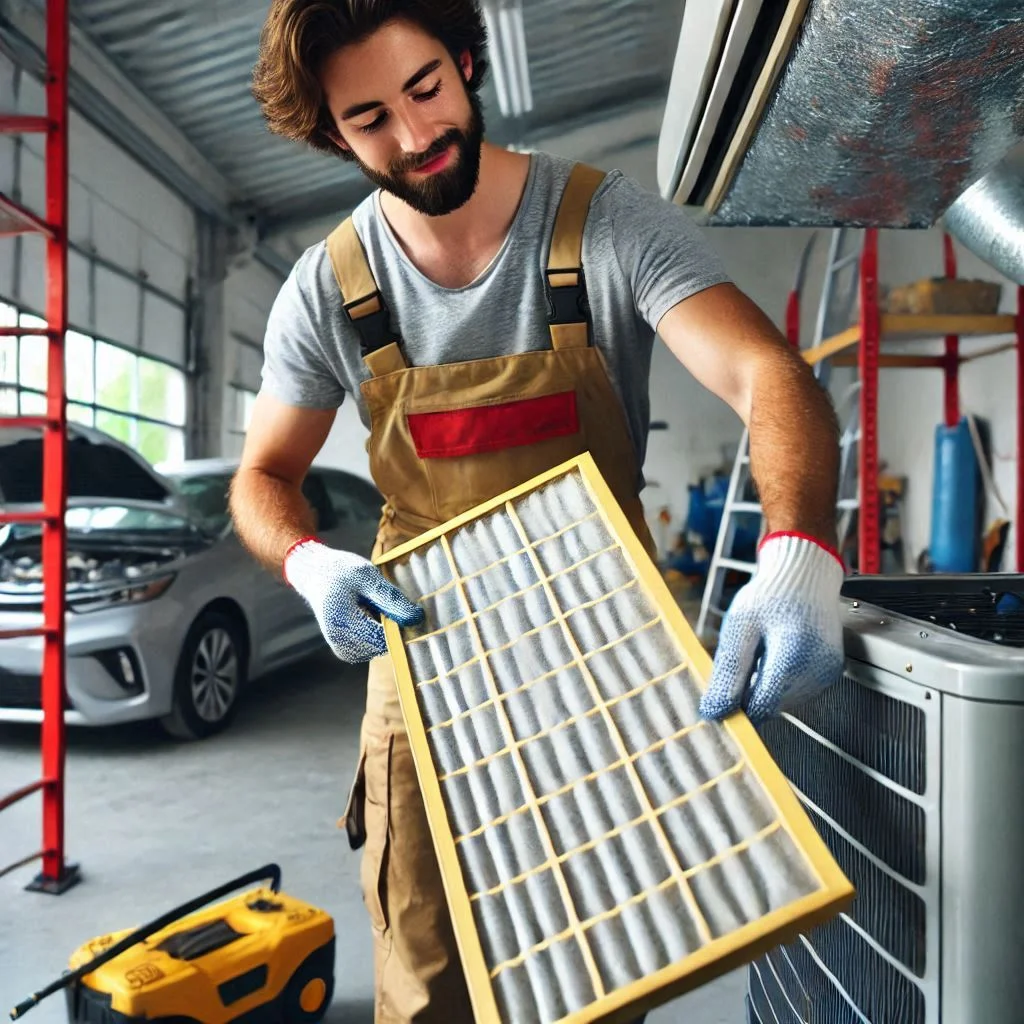
Checking for Leaks and Blockages
Another crucial step in maintaining your garage gym’s AC system is checking for leaks and blockages. Leaks in the refrigerant lines or the ductwork can cause the system to lose cooling power and efficiency.
Why Leaks and Blockages Matter:
- Reduced Efficiency: Refrigerant leaks decrease the cooling capacity of your AC. Blockages in ducts can prevent cool air from circulating properly, making the system less effective at maintaining a comfortable temperature.
- Increased Energy Costs: A system with leaks or blockages works harder to reach the desired temperature, leading to higher energy consumption and increased utility bills.
- System Damage: If not addressed, leaks or blockages can cause long-term damage to your AC unit, potentially leading to costly repairs or even the need for a complete replacement.
How to Check for Leaks and Blockages:
- Inspect Ductwork: Look for visible signs of wear, such as cracks or gaps in the ducts. Seal any gaps with appropriate duct tape or mastic.
- Check Refrigerant Lines: Examine the refrigerant lines for any visible damage. If you suspect a leak, contact a professional HVAC technician for a refrigerant check.
- Clean Drain Lines: Ensure that the condensate drain line is clear of debris. Clogged drain lines can lead to water damage and reduced cooling efficiency.
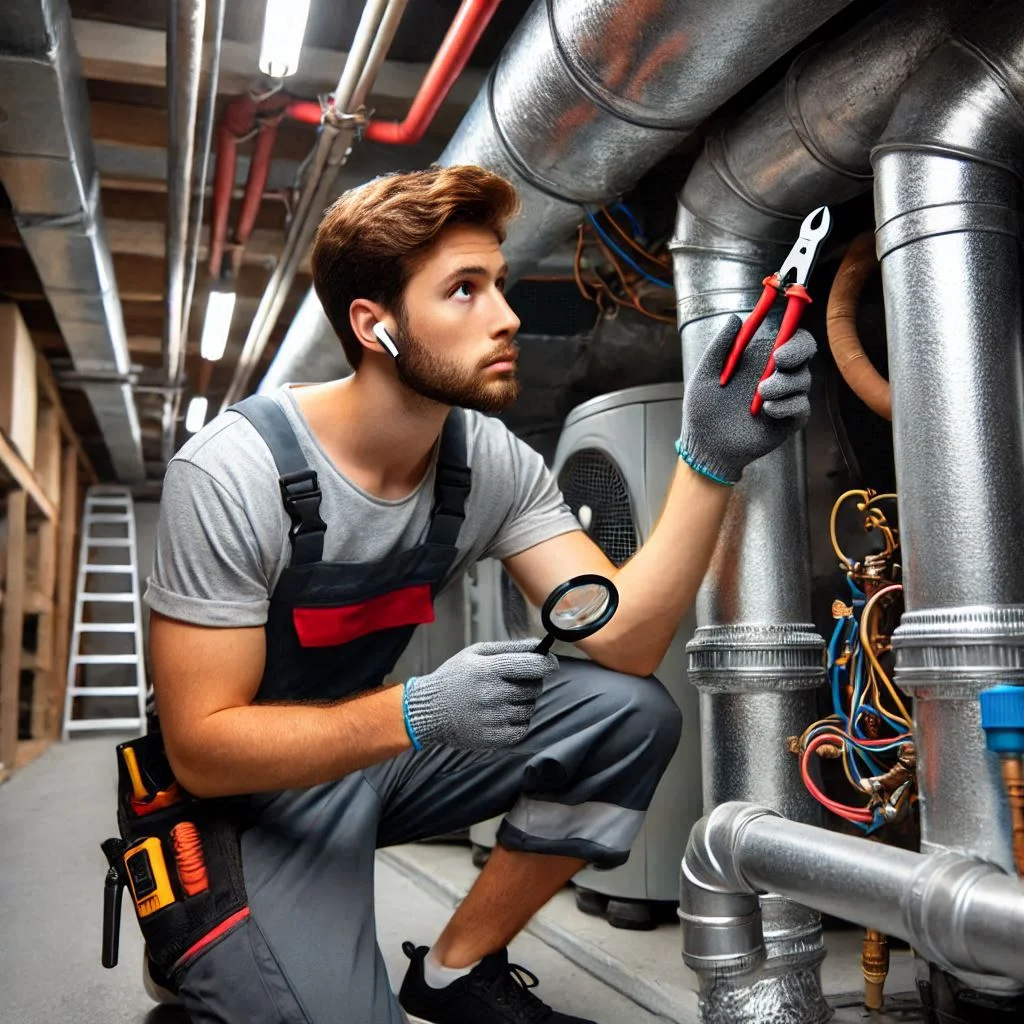
Professional Maintenance Services
While regular DIY maintenance is essential, it’s also important to schedule professional maintenance services to ensure that your AC is running at its best. Professional technicians can perform more detailed inspections and repairs that may be difficult or dangerous for homeowners to handle.
Why Professional Services are Essential:
- Thorough Inspections: HVAC professionals have the expertise to perform in-depth inspections of all components of your AC system, ensuring that nothing is overlooked.
- Preventative Care: A professional can identify potential issues before they become major problems, saving you from costly repairs in the future.
- System Calibration: Technicians can calibrate the system for optimal performance, ensuring that the thermostat and other settings are properly adjusted.
When to Call a Professional:
- Annual Tune-ups: Schedule a professional tune-up once a year to ensure that your AC system is working efficiently. Many technicians offer seasonal maintenance packages.
- If You Notice Issues: If your AC is not cooling effectively, making unusual noises, or showing any signs of malfunction, it’s time to call in an expert.
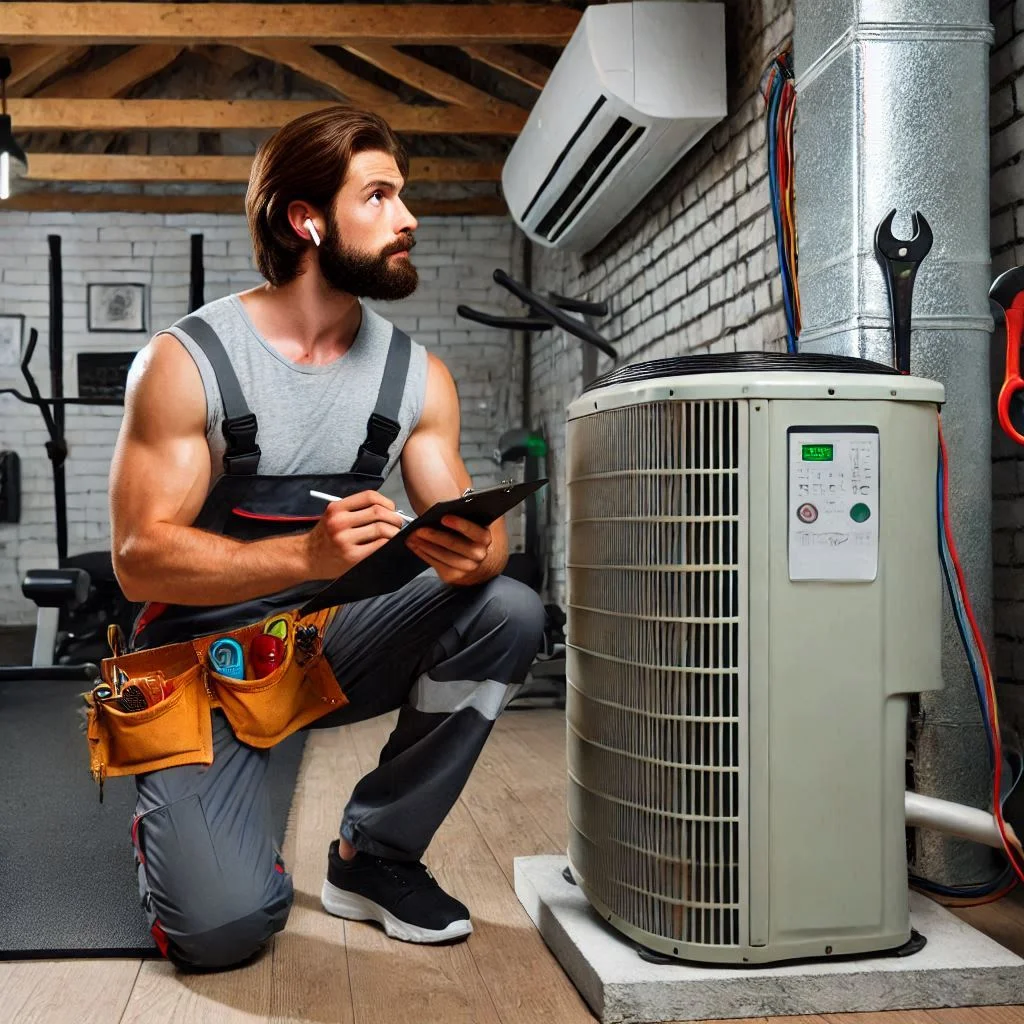
Frequently Asked Questions About Installing and Maintaining an Air Conditioner in Your Garage Gym
Adding an air conditioner (AC) to your garage gym can enhance your workout environment by ensuring that the temperature is comfortable, no matter how intense the training. Here are some common questions related to garage gym AC systems, along with expert answers to guide you in making the right decision.
Can I Install an Air Conditioner in My Garage Gym Myself?
While it is possible to install a basic air conditioner, such as a portable or window unit, yourself, installing more complex systems, like mini-split systems, typically requires professional expertise.
Why You Might Want to DIY:
- Portable or Window Units: These types of AC units are designed for easy installation. If you have basic DIY skills, you can usually install these units in your garage gym without needing professional help.
- Cost-Effective: Installing an air conditioner yourself can save you the expense of labor costs.
Why Professional Installation is Better:
- Mini-Split or Central AC Systems: These systems require proper placement, refrigerant handling, and electrical work, making them more suitable for professionals. Incorrect installation can cause inefficiencies, potential damage, or even safety risks.
- Proper Sizing and Placement: An HVAC professional will ensure that your AC is appropriately sized for your garage gym and properly placed for optimal airflow and cooling.
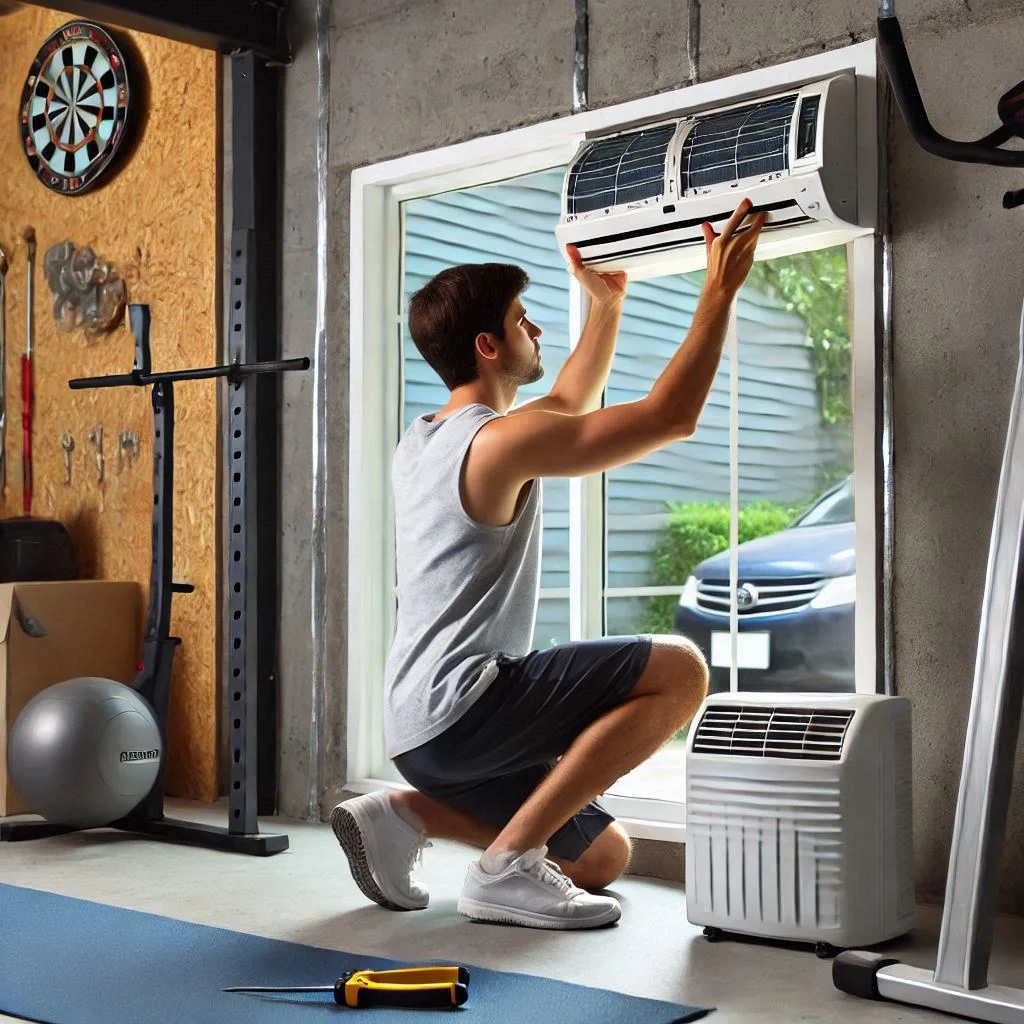
What is the Most Energy-Efficient Air Conditioner for a Garage Gym?
Energy efficiency is crucial when selecting an air conditioner for your garage gym, as it can help you save on energy bills and reduce your environmental impact.
Top Energy-Efficient Options:
- Ductless Mini-Split Systems: These units are highly efficient because they don’t require ductwork, which can waste energy. They are designed to cool specific areas, like your garage gym, without significant energy loss.
- Inverter Technology: AC units with inverter technology can adjust their speed based on the room temperature, leading to less energy consumption compared to traditional units that constantly cycle on and off.
- Energy Star Certified Models: Look for AC units that are Energy Star certified. These models meet rigorous energy efficiency standards and are ideal for reducing energy costs.
Tips for Maximizing Energy Efficiency:
- Proper Sizing: Ensure that your AC unit is the right size for your garage gym. An oversized unit will cycle on and off too frequently, using more energy.
- Regular Maintenance: Keep your AC unit in top condition with regular cleaning, filter replacement, and annual tune-ups.
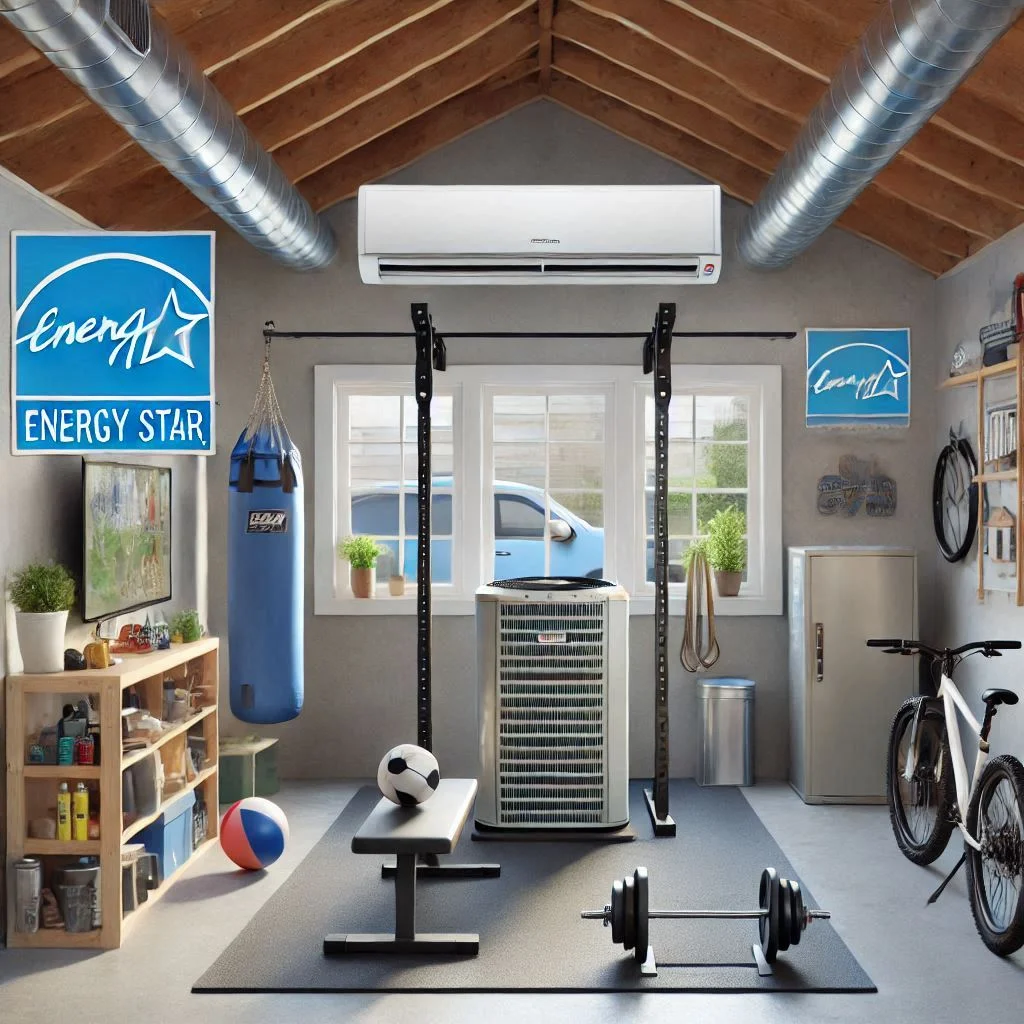
How Much Does It Cost to Install an Air Conditioner in a Garage Gym?
The cost of installing an air conditioner in your garage gym can vary significantly based on the type of system you choose, its size, and whether you opt for professional installation.
Cost Breakdown by AC Type:
- Portable AC Units: These are the most affordable option, typically ranging from $200 to $600. Installation is simple, often requiring just a window vent kit.
- Window AC Units: Window units cost between $150 and $750, with installation fees usually around $100–$300.
- Mini-Split AC Systems: These are the most expensive, with prices starting around $1,500 for the unit and installation. However, mini-split systems offer high energy efficiency and cooling performance.
- Central AC Systems: If you have a larger garage gym or need to cool multiple areas, a central air conditioning system may cost between $3,000 and $7,000 for both the unit and installation.
Additional Costs:
- Ductwork: If you’re installing a central AC system, you may also need to install or modify ductwork, which can increase the overall cost.
- Maintenance: Regular maintenance, such as cleaning filters or servicing the unit, can cost an additional $100–$200 annually.
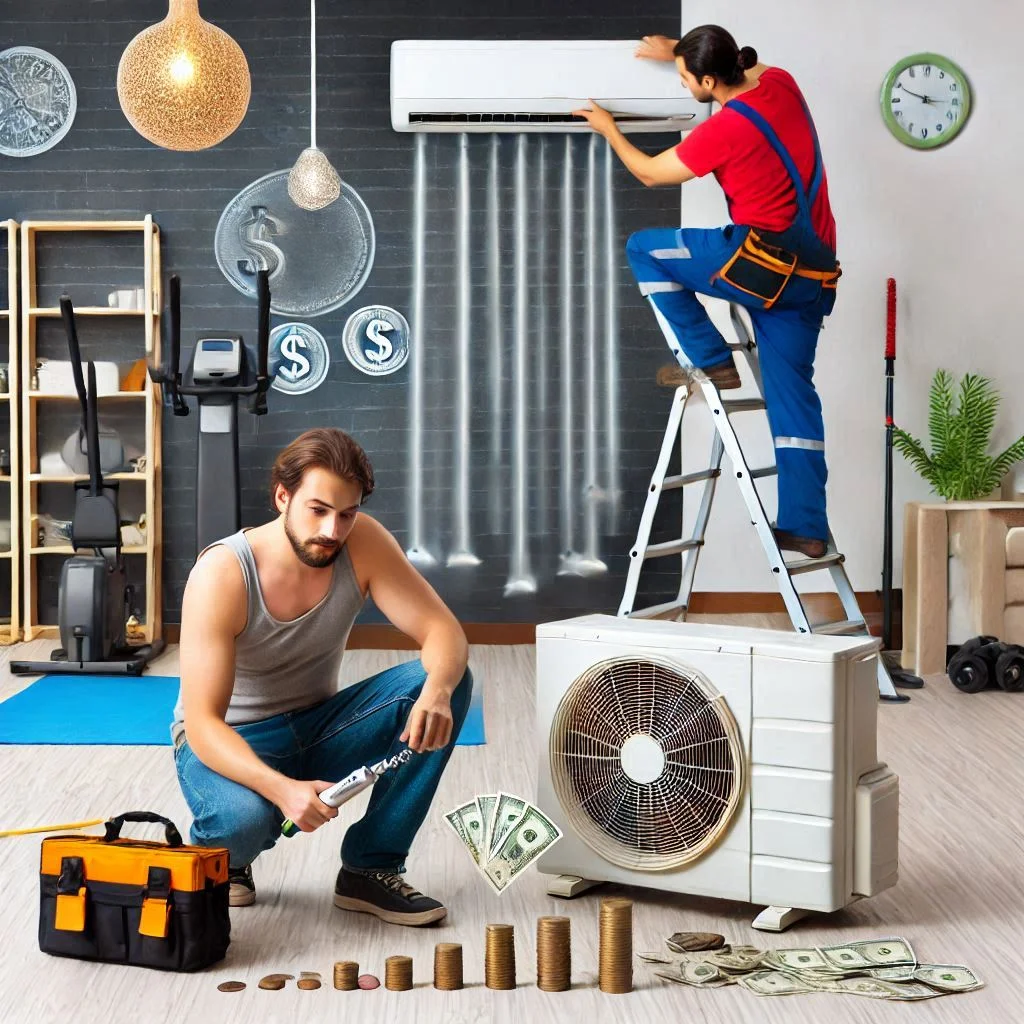
How Do I Maintain My Garage Gym Air Conditioner?
Proper maintenance is essential to ensure that your garage gym air conditioner works efficiently and lasts longer. Here’s how you can keep your system in top condition:
1. Regular Cleaning and Filter Replacement:
- How Often? Clean the filter every 1–3 months, depending on usage, and replace it every 6 months.
- Why? A dirty filter reduces airflow, leading to inefficient cooling and higher energy bills.
2. Check for Leaks and Blockages:
- Inspect the refrigerant lines and ducts for leaks or blockages. A small leak can lead to a significant loss of cooling efficiency and higher energy costs.
- Tip: Ensure the drain lines are clear to avoid water damage.
3. Annual Professional Maintenance:
- Schedule a professional tune-up at least once a year. This allows a technician to check for potential problems and ensure that your system is running at its best.
- Tip: A professional can also clean coils, check refrigerant levels, and calibrate the system for optimal performance.
4. Keep the Area Clean:
- Dust, dirt, and debris can accumulate around the AC unit and obstruct airflow. Keep the area around the AC clear to ensure maximum performance.
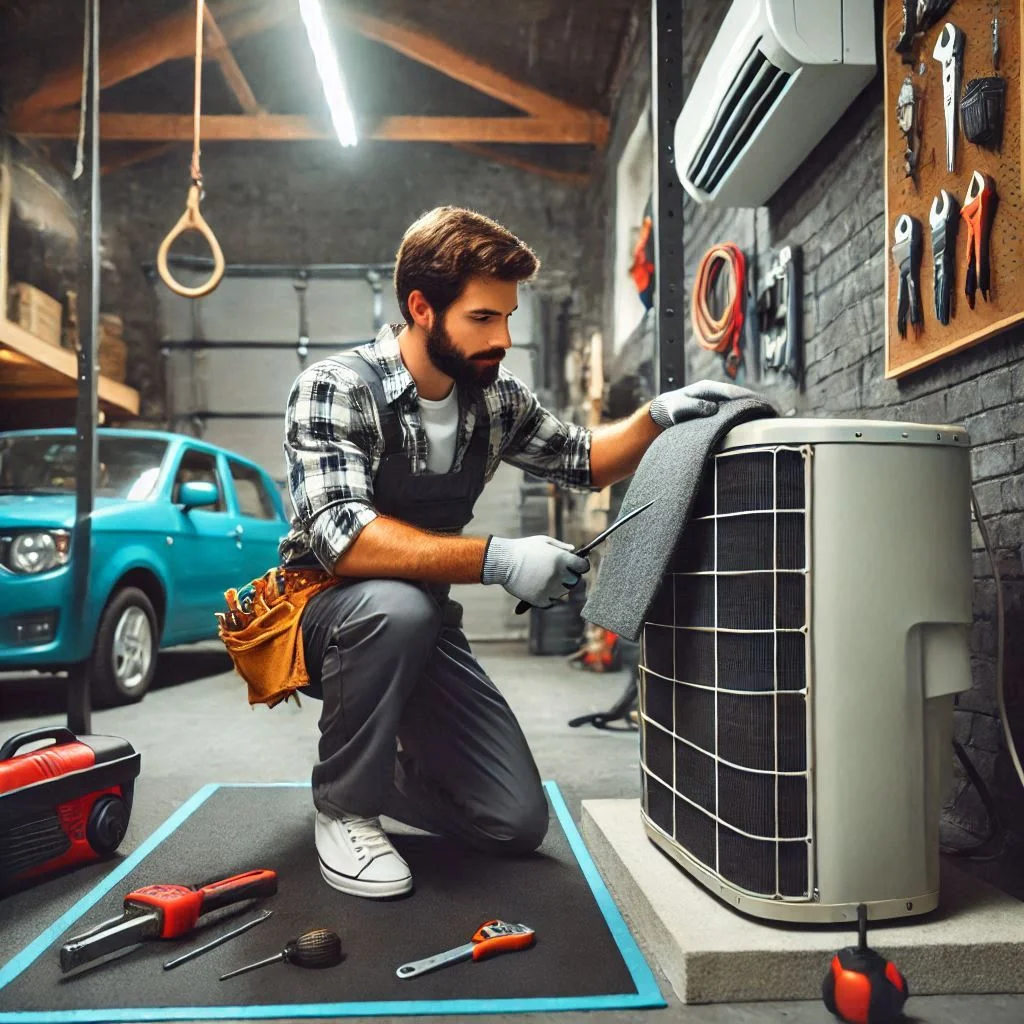
Conclusion:
In conclusion, installing the right air conditioner in your garage gym is a smart way to enhance your workout environment, providing comfort and ensuring optimal performance. Whether you opt for a portable unit, window AC, or a more advanced mini-split system, each option offers its own set of benefits tailored to your space and needs. By considering factors like energy efficiency, proper maintenance, and the ideal installation methods, you can ensure that your garage gym stays cool throughout the year. With the right knowledge and preparation, you can make an informed decision and create a comfortable space that enhances your training experience, helping you stay focused and motivated during every session. Don’t forget to regularly maintain your AC unit to keep it running efficiently and extend its lifespan for long-term performance.

